
1938年から1939年のナチスドイツによるチベット探検
The 1938–1939 Nazi-German expedition to Tibet
Bruno Beger (right) with the Tibet expedition and their Sikkimese interpreters, Kaiser Bahadur Thapa and Rabden Khazi, in 1938.
このページの情報は、すべて、1938-1939年 のドイツのチベット探検(英語版:1938–1939 German expedition to Tibet)[Das Bundesrchiv, Search]な どから採ったものである。さて、1938-1939年のドイツ・チベット遠征は、 1938年4月から1939年8月にかけて、ドイツの動物学者でSS隊員のエルンスト・ シェーファー(Ernst Schäfer)が率いたドイツの科学探検隊である。このページは情報がたくさんあり非常に長いので、目次(タグジャンプします)を示す。
1.1938-1939年のドイツ・チベット遠征とブルーノ・ベガーに着目 して
2.探検の概要:1938–1939 German expedition to Tibet.(隊長:シェーファーに着目して)
6.スヴェン・ヘディン内陸アジア研究所(1934年1月1日〜1945年 12月31日)
7.DFGの沿革, German Research Foundation - Deutsche Forschungsgemeinschaft.
++++++++++++++++++++
01. 1938-1939年のドイツ・チベット遠征とブルーノ・ベガーに着目して
ブルー
ノ・ベガー(Bruno Beger、1911年4月27日 -
2009年10月12日)は、ドイツの人種人類学者、民族学者、探検家であり、アーネンエルベに勤務していた人物である。1938年から39年にかけてエ
ルンスト・シェーファーのチベット旅行に参加し、SSの人種・移住局(SS-
Rasse- und
Siedlungshauptamt)でユダヤ人の識別を手伝い、後にユダヤ人の骨格の解剖学研究コレクションを作るために殺される被験者を選ぶのに協力
した。
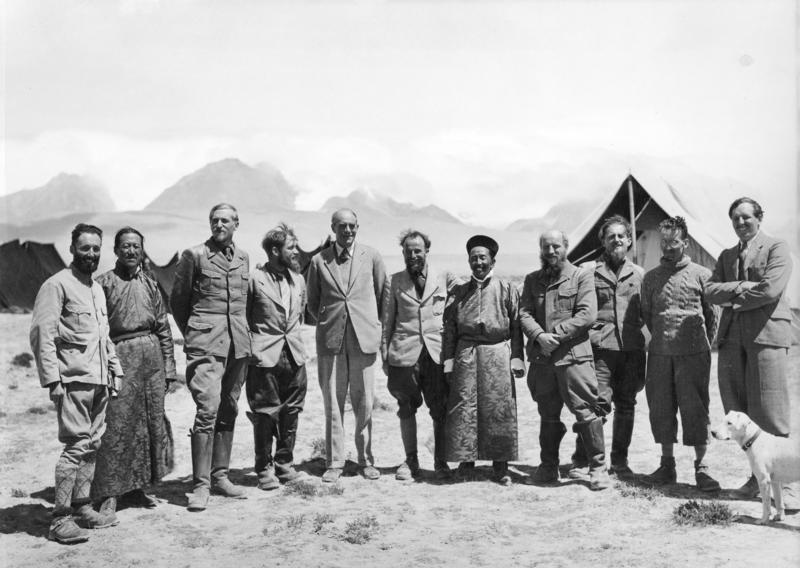 |
Expedition
members with hosts in Gangtok,
Sikkim are (from left to right) unknown, unknown Tibetan, Bruno Beger, Ernst Schäfer,
Sir Basil Gould,
Krause, unknown Tibetan, Karl Wienert,
Edmund Geer, unknown,
unknown.
写真はBundesarchiv, Bild 135-KA-11-008 /
CC-BY-SA 3.0. Sir Basil Gouldは、英 国の領事 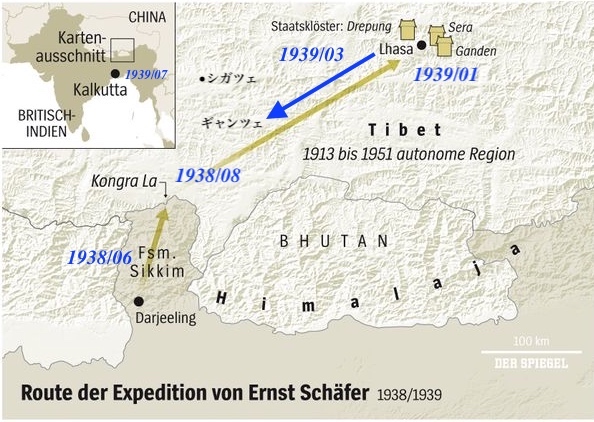 地図の出典は、Die abenteuerliche Nazi-Expedition in den Himalaja, Von Matthias Schulz. 24.03.2017, Spiegel Wissenshaft. |
 |
Bruno Beger (right) with the Tibet
expedition and their Sikkimese interpreters, Kaiser Bahadur Thapa and
Rabden Khazi, in 1938. Bundesarchiv, Bild 135-KA-10-063 / Krause, Ernst / CC-BY-SA 3.0. 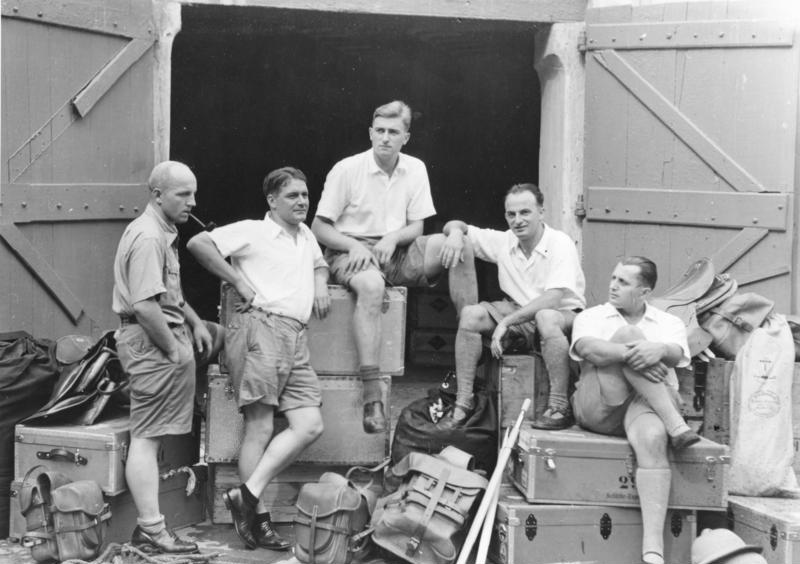 Krause, Ernst撮影[von links
nach rechts: Wienert, Schäfer, Beger, Krause, Geer] Krause, Ernst撮影[von links
nach rechts: Wienert, Schäfer, Beger, Krause, Geer]+++ Beger, Bruno Dr.: SS-Hauptsturmführer, Abteilungsleiter Sven-Hedin-Institut, Deutschland (GND 128720654):自然人類学者 Schäfer, Ernst Dr.: SS-Sturmbannführer, Leiter des Sven-Hedin-Institutes, Deutschland (GND 123991420):鳥類学者、探検隊長 Krause, Ernst: Mitarbeiter im Sven-Hedin-Institut, Deutschland:昆虫学者 Geer, Edmund. (キャリア不詳):登山家 Wienert, Karl A.(地学者?) Karl Wienert, Rilevamenti del magnetismo nel Tibet (イタリア語, 1945) Detections of magnetism in Tibet |
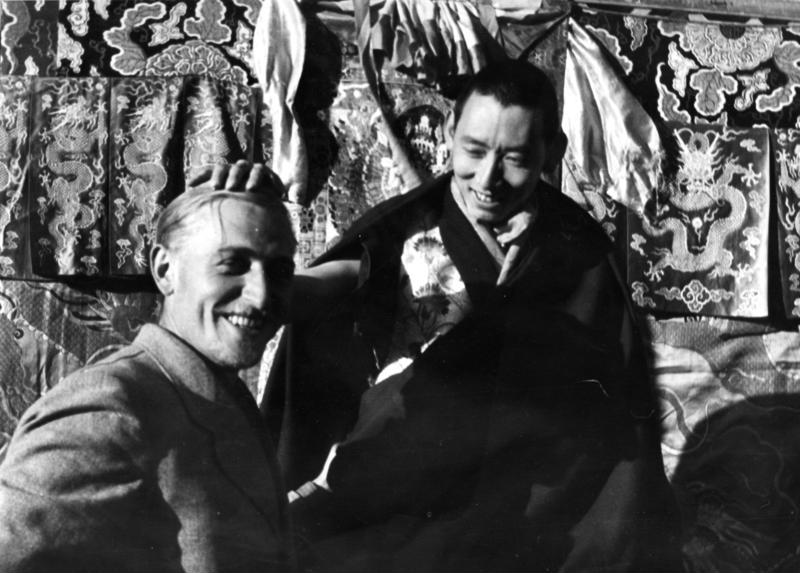 |
Bruno Beger with the Regent of
Tibet, in Lhasa. Bundesarchiv, Bild 135-S-13-11-15 / Schäfer, Ernst / CC-BY-SA 3.0 File:Bundesarchiv Bild 135-S-13-11-15, Tibetexpedition, Regent von Tibet mit Beger.jpg Created: 1938date QS:P571,+1938-00-00T00:00:00Z/9 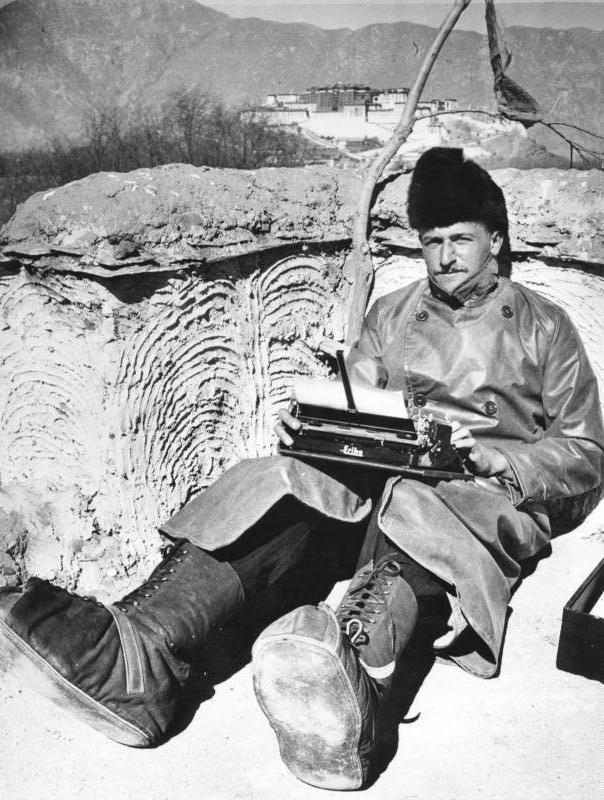 Bruno Beger bei der Tibetexpedition (1938 bis 1939), Bundesarchiv, Bild 135-KB-16-031 / CC-BY-SA 3.0 |
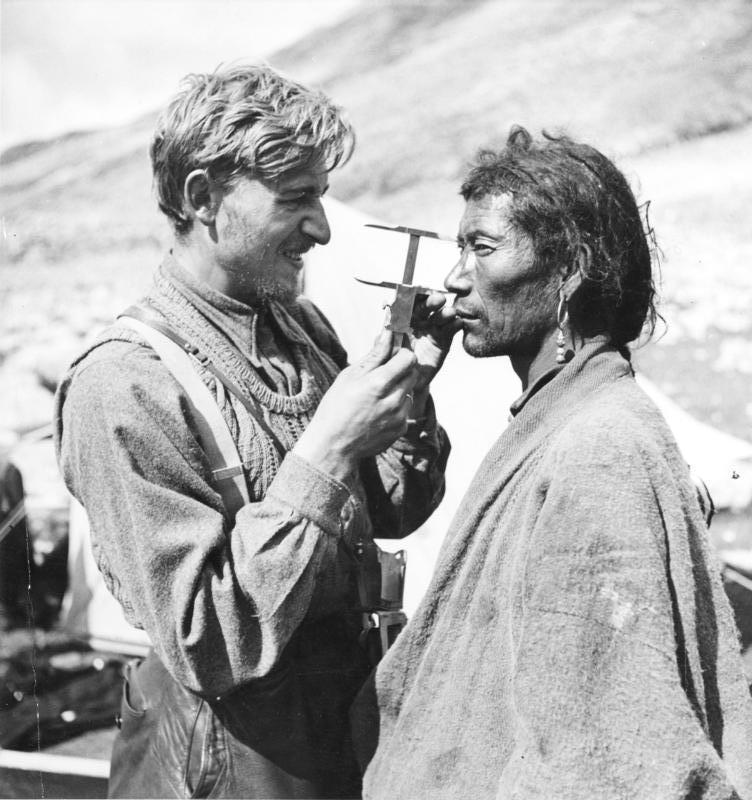 |
ブルーノ・ベガー[ベーガー](Bruno
Beger、1911年4月27日 -
2009年10月12日)は、ドイツの人種人類学者、民族学者、探検家であり、アーネンエアベ(アー
ネンエアベ協会)に勤務していた人物である。1938年から39年にかけてエ
ルンスト・シェーファーのチベット旅行に参加し、SSの人種・居住局(SS-Rasse- und
Siedlungshauptamt)でユダヤ人の識別を手伝い、後にユダヤ人の骨格の解剖学研究コレクションを作るために殺される被験者を選ぶのに協力
した。 ベガーは1911年にハイデルベルクの旧家に生まれたが、まもなく第一次世界大戦で父親が戦死し、苦境に立たされた。しかし、家族の友人の援助でイエナ大 学(Friedrich-Schiller-Universität Jena) に入学し、講義で初めてハンス F. K. ギュンター(ハンス・ ギュンター, 1891-1968)に触れ、人類学と民族学の分野で初期の学究生活に励むことになる。 1934年、ブルーノ・ベガー(Bruno Beger,1910/1911-2009)はSSの人種・入植局で非常勤の仕事を始め、やがて課長となった。ベガーは、ハワイ遠征の依頼を受け たが、最終的な承認を待っている間に、エルンスト・シェーファー(Ernst Schäfer, 1910-1992)が率いるチベットの旅に招かれ、これを引き受けた。 ベガーは、シェーファーに宛てた企画書の中で、「測定、形質調査、写真撮影、型取りなどを通じて、現在の人種・人類学の状況を研究し、この地域における北 欧人種の割合、起源、意義、発展に関する資料を収集すること」をこの探検への貢献として述べている。 ベガーは探検の間中、旅日記を書き続け、60年後に"Mit der deutschen Tibetexpedition Ernst Schäfer 1938/39 nach Lhasa (Wiesbaden, 1998)"として出版された。現存するのは50部のみである。 Bruno Beger busy taking cranial measurements Bundesarchiv, Bild 135-KB-15-089 / Krause, Ernst / CC-BY-SA 3.0 File:Bundesarchiv Bild 135-KB-15-089, Tibetexpediton, Anthropometrische Untersuchungen.jpg Created: 1938date QS:P571,+1938-00-00T00:00:00Z/9 photographs taken by Ernst Krause in 1938 |
 |
Bruno Beger busy
taking cranial measurements Bundesarchiv, Bild 135-KB-15-089 / Krause, Ernst / CC-BY-SA 3.0 File:Bundesarchiv Bild 135-KB-15-089, Tibetexpediton, Anthropometrische Untersuchungen.jpg Created: 1938date QS:P571,+1938-00-00T00:00:00Z/9 photographs taken by Ernst Krause in 1938 |
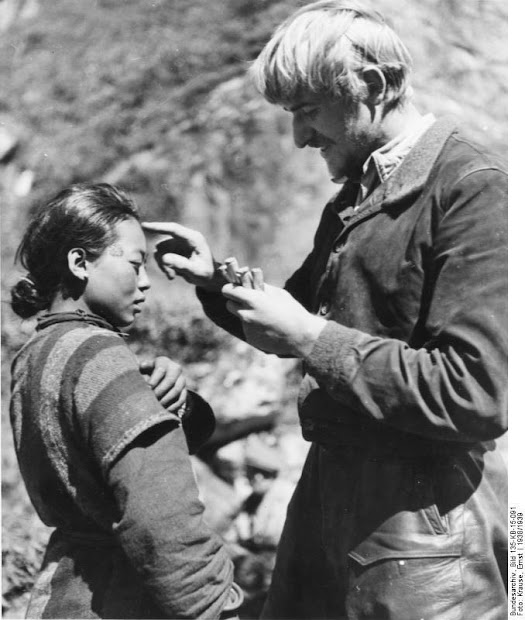 |
「多様性は美しい」語りかける映像。チ
ベットでアトランティスとアーリア神話を探す,
2017年10月16日(月)(※かなり怪しい内容、この程度の記載は、ウィキペディア閲覧などで書けるレベル)→Diversity
is beautiful, Monday, 16 October 2017, Narrative images: Searching for
Atlantis and the Aryan Myth in Tibet photographs taken by Ernst Krause in 1938 |
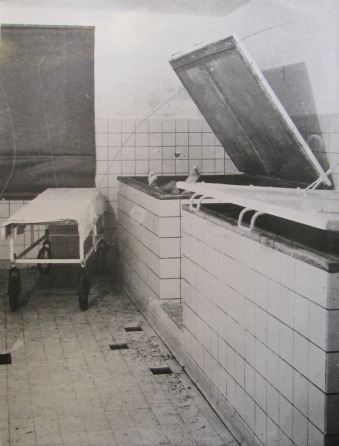 |
その後の、ブ
ルーノ・ベガー(ユダヤ人骨格コレクションへの参加)(→「バ
イオエシックスと国家が結びつくとナチズムになる」) ベガーはアウグスト・ヒルト(→)とともに帝国大学シュトラスブルク校( Reichsuniversität Straßburg)に勤務していた。彼の任務は、ヒルトの被験者の死を伴う人種実験のために、様々な強制収容 所から多様な民族の収容者をナチスの医師に提供することだった。この仕事では、アウシュビッツから100人以上の人間を選んで殺害し、その骨格をユダヤ人 骨格コレクションとして展示することであった。彼らは主にユダヤ人であり、その犯罪は1946年のニュルンベルク裁判で暴露された。このコレクションは、 ハインリッヒ・ヒムラー親衛隊大将の認可を受け、アウグスト・ヒルトの指揮のもとに設計され、ルドルフ・ブラントとアーネンナーベ総支配人のウォルフラ ム・シーヴァースが死体の調達と準備を担当した。犠牲者はナッツヴァイラー強制収容所に送られ、収容所長のヨーゼフ・クラマー親衛隊上級大将によってガス 処刑されました。その死体は、シュトラスブルクのヒルトの元に送られた。この作業には、医師のハンス・エンドレス、ハンス・フライシュハッカー、ハイン リッヒ・リューベル、ルドルフ・トロイヤンらが協力した。 1948年2月、ベガーは、骨格収集の役割を知らないまま、ナチス戦争犯罪裁判によって「無罪」にされた。1960年、ルートヴィヒスブルクでコレク ションに関する調査が始まり、ベガーは1960年3月30日に拘束された。ベガーは1960年3月30日に拘束されたが、4ヵ月後に釈放された。その後、 1970年10月27日に裁判にかけられるまで、捜査は続けられた。ベガーは、自分が測定したアウシュビッツの囚人が殺されるとは知らなかったと主張して いる。この裁判で起訴された他の2人は釈放されたが、ベガーは1971年4月6日に有罪判決を受け、86人のユダヤ人殺害の共犯者として3年の刑を宣 告されました。控訴審では、3年の保護観察処分に減刑された。ベガーの家族によると、ベガーは2009年10月12日にケーニヒシュタイ ン・イム・タウヌ スで死去した。 The Anatomical Institute of the Reichsuniversität Strassburg, 写真は https://doi.org/10.1016/j.aanat.2016.03.006 より。 |
++++++++++++++++++++++
02. 探検の概要:1938–1939 German expedition to Tibet.
| Origins |
Nazi
Reichsführer-SS Heinrich Himmler wished to use the reputation of the
scientist and explorer Ernst Schäfer for Nazi propaganda after
Schafer's first two trips to China and Tibet in 1930 to 1931 and 1934
to 1936 came to Himmler's attention. Himmler asked about Schafer's
future plans. Schäfer responded that he wanted to lead another
expedition to Tibet and requested for his expedition to be under the
patronage of the cultural department of the Foreign Affairs Department
or of the Deutsche Forschungsgemeinschaft ("German Research
Foundation"). Himmler was fascinated by Asian mysticism and therefore
wished to send such an expedition under the auspices of the SS
Ahnenerbe (SS Ancestral Heritage Society), and he desired for Schäfer
to perform research based on Hanns Hörbiger's pseudoscientific theory
of "Glacial Cosmogony," promoted by the Ahnenerbe. Schäfer had
scientific objectives and therefore refused to include Edmund Kiss, an
adept of the theory, in his team and required 12 conditions to ensure
scientific freedom. Wolfram Sievers, from the Ahnenerbe, therefore
expressed criticism concerning the objectives of the expedition, and
Ahnenerbe would not sponsor it. Himmler was agreeable to the expedition
going ahead if all members joined the SS, and Schäfer found that he had
no alternative but to accept that condition even without sponsorship. |
ナチスのハインリッヒ・ヒムラー親衛
隊大将は、エルンスト・シェーファー(Ernst Schäfer)
が1930年から1931年、1934年から1936年にかけて中国とチベットを旅行したことがヒムラーの目に留まり、科学者で探検家のエルンスト・
シェーファーの評判をナチのプロパガンダに利用しようと考えていた。ヒムラーは、シェーファーの将来の計画について質問した。シェーファーは再度チベット
遠征をしたいと答え、その遠征は外務省の文化局かドイツ研究財団(Deutsche
Forschungsgemeinschaft,
DFG)の後援のもとに行うよう要請した。ヒムラーはアジアの神秘主義に魅了されていたので、SSアーネンエアベ(SS Ancestral
Heritage Society)の後援のもとにそのような探検隊を送ることを希望し、アーネンエルベが推進するハンス・ヘルビガー(Hanns
Hörbiger)の「氷河宇宙論」の疑似科学的理論に基づいて研究を行うようシェーファーに望んだのである。シェー
ファーには科学的目的があったので、この理論の信奉者であるエドマンド・キス(Edmund
Kiss)をチームに加えることを拒否し、科学的自由を確保するために12の条件を要求した。そのため、アーネンエルベのウォルフラム・シーバース
(Wolfram
Sievers)は、この探検の目的について批判し、アーネンエルベはスポンサーにならないことになった。ヒムラーは、全員が親衛隊に入隊するならば、遠
征を実施することに同意しており、シェーファーは、スポンサーなしでもこの条件を受け入れるしかなかった。 |
| Designations |
While
he prepared the expedition, Schäfer used the term "Schaefer Expedition
1938/1939" on his letterhead and to apply for sponsorship from
businessmen. The official expedition name had to be changed by order of
the Ahnenerbe, however, to German Tibet-Expedition Ernst Schaefer (in
capital letters), "under the patronage of the Reichsführer-SS Himmler
and in connection with the Ahnenerbe" (in small letters). After the German Consul-General in Calcutta had criticized the letterhead in a report to the German Foreign Office by "arguing that the prescribed letterhead was counter-productive and immediately generated mistrust among the British," Schäfer "ordered a new, discreet letterhead in Antiqua font, which read 'Deutsche Tibet Expedition Ernst Schäfer'."During the expedition, Schäfer used only the latter letterhead or his original "Schaefer Expedition" paper. The Ahnenerbe-prescribed letterhead was used only prior to the expedition's departure. The British writer Christopher Hale claims that one cannot infer that Schäfer was independent of the SS and could do "pure science" simply from the special letterhead that he got printed for the expedition. To all intents and purposes, the expedition remained under Himmler's patronage, and Schäfer had no interest in losing his support. In its time, the expedition was also commonly referred to in German newspapers and academic journals as the "SS Tibet Expedition," as it had Himmler as its patron, and all five members were SS officers. The "SS Tibet Expedition" designation was used by Schäfer himself in the Atlantis Journal. "SS Tibet Expedition" is the title used in a 1946 report by US military intelligence in Western Europe. In the "Register of the Heinrich Himmler Papers," 1914–1944, archived at Stanford University's Hoover institution, the folder containing the material pertaining to the expedition bears the title "The SS-Tibet-Expedition, 1939. That designation is still in use by modern scholars, such as Mechtild Rössler in 2001, and Suzanne Heim in 2002,as well as by the writer Peter Lavenda in 2002. |
シェーファーは遠征の準備中、便箋に「シェーファー遠征隊1938/1939」
という言葉を使い、実業家にスポンサーを申請していた。しかし、遠征隊の正式名称は、アーネンエアベの命令により、「ヒムラー総統の後援の下、アーネンエ
アベに関連して」(小文字)、「ドイツチベット遠征エルンスト・シェーファー」(大文字)に変更せざるを得なくなった。 カルカッタのドイツ総領事がドイツ外務省への報告で「所定の便箋は逆効果で、直ちに英国人の不信感を招くと主張」して批判した後、シェーファーは「アン ティカ書体の『ドイツ・チベット遠征エルンスト・シェーファー』と書かれた新しい目立たない便箋を注文」し、遠征中はこの便箋かオリジナルの「シェー ファー遠征」紙のみを使用した。アーネンエアベ規定の便箋は、遠征出発前にのみ使用 された。 イギリスの作家クリストファー・ヘイルは、シェーファーが遠征のために印刷させた特 別な便箋からだけでは、SSから独立して「純粋科学」ができたと推論することはできないと主張している。遠征隊はどこまでもヒムラーの庇護のもとにあり、[他方で]シェーファーはヒムラーの支持を失うことには何の興味もなかった。 当時、ドイツの新聞や学術誌では、ヒムラーを後援者とし、5人の隊員が全員親衛隊員であることから、「SSチベット遠征隊」とも呼ばれた。「SSチベット遠征隊」という呼称は、シェーファー自身が『アトランティスジャーナル』の中で 使っていた。"SS Tibet Expedition "は、1946年に西ヨーロッパにあるアメリカ軍情報部による報告書で使用された呼称で ある。 スタンフォード大学のフーバー研究所に保管されている「ハインリッヒ・ヒムラー文書登録簿」1914-1944では、遠征に関する資料を含むフォルダーに 「SSチベット遠征、1939」というタイトルが付けられている。 この名称は、2001年のMechtild Rössler、2002年のSuzanne Heim、2002年の作家Peter Lavendaなど、現代の研究者たちによって現在も使用されている。 |
| Funding |
According
to Christopher Hale, as Schäfer was demanding more than 60,000
Reichsmarks for his expedition, and the coffers of the SS were depleted
at the time, he was forced to raise the funds himself. According to researcher Isrun Engelhardt, the expedition was not funded by the Ahnenerbe. Schäfer raised the funds by himself, 80% of which came from the Public Relations and Advertising Council of German Industry (Werberat der deutschen Wirtschaft) as well as large German business enterprises, Deutsche Forschungsgemeinschaft (German Research Foundation) and Brooke Dolan II. Himmler's personal friends sponsored only the flight back to Germany. According to the United States, the expedition's funding was provided by various public and private contributors, with the return flight to Germany being paid for by the SS. The cost of equipping the expedition was RM 65,000, and the expedition itself cost another RM 65,000, excluding the flight back. |
クリストファー・ヘイル
(Christopher
Hale)によると、シェーファーは遠征のために6万ライヒスマルク以上を要求し、当時SSの金庫が枯渇していたため、自分で資金を調達することを余儀な
くされたという。 研究者のイスルン・エンゲルハルトによれば、この遠征はアーネンエアベの資金提供を受けていたわけではなかった。シェーファーは自分で資金を調達したが、 その8割はドイツ産業広報広告協議会(Werberat der deutschen Wirtschaft)のほか、ドイツの大企業、ドイツ研究財団、ブルック・ドラン2世からであった。ヒムラーの個人的な友人たちは、ドイツに戻る便だけ を後援した。 米国によると、探検隊の資金は官民のさまざまな寄付者によって提供され、ドイツへの帰国便はSSによって支払われたという。遠征隊の装備費は6万5千ライ ヒスマルク、遠征そのものは帰りの便を除いてさらに6万5千ライヒスマルクかかったという。 |
| Members |
Ernst
Schäfer was a member of the SS when he arrived at the German consulate
in Chungking in 1935. He had just returned from a trip through parts of
Asia, mainly India and China, in which the two other heads of the
expedition had abandoned him out of fear of the native tribes. Schäfer
turned the expedition from a complete failure into a great success, and
the SS took note by sending him a letter informing him of a promotion
to SS-Untersturmführer and summoning him back to Germany from
Philadelphia, Pennsylvania. In June 1936, Schäfer met with Himmler, who
informed Sievers and Galke to start organizing an expedition to Tibet. Schäfer recruited young, fit men who would be well suited for an arduous journey. At 24, Karl Wienert (an assistant of Wilhelm Filchner, a famous explorer) was the team's geologist. Also 24, Edmund Geer was selected as the technical leader to organize the expedition. A relatively-old teammate, who was 38, was Ernst Krause (not to be confused with the German biologist of the same name), who was to double as a filmmaker and an entomologist. Bruno Beger was a 26-year-old Rassekunde expert and student of Hans F.K. Günther and was to be the team's anthropologist. |
エ
ルンスト・シェーファーは、1935年に重慶のドイツ領事館に到着したとき(すでに)SSのメンバーであった。彼は、インドと中国を中心としたアジアの旅
から戻っ
たばかりで、他の2人の探検隊長は先住民への恐怖から彼を見限っていた。(しかし)シェーファーはこの遠征を大成功に収め、親衛隊は彼に親衛隊少尉(SS
-Untersturmführer)への昇進を知らせる手紙を送り、ペンシルバニア州のフィラデルフィアからドイツに呼び戻したのである。1936年6
月、シェーファーはヒムラーと会談し、シーバースとガルケにチベット遠征の準備を始めるよう伝えた。 シェーファーは、過酷な旅に適した若く健康な男たちを採用した。24歳のカール・ヴィーネルト(有名な探検家ヴィルヘルム・フィルチナーの助手)は、チー ムの地質学者となった。また、遠征隊をまとめる技術リーダーには、24歳のエドモンド・ギアが選ばれた。38歳の比較的年長のチームメイトは、映画監督と 昆虫学者を兼ねることになったエルンスト・クラウス(ドイツの同名の生物学者と混同してはいけない)である。ブルーノ・ベーガーは26歳の人種科学 (Rassekunde)の専門家で、ハンス・F・K・ギュンターの教え子であり、チームの人類学者となる予定であった。 |
| Objectives |
The
researcher Roger Croston described the objective of the expedition as
"an holistic creation of a complete biological record of Tibet
alongside a synthesis of inter-relating natural sciences with regard to
geography, cartography, geology, earth magnetics, climate, plants,
animals and mankind." Reacting to Dr Isrun Engelhardt's conclusions that the Schäfer expedition was "purely scientific" and her claim that the historical context of Germany in the 1930s made the expedition's goals appear as somehow sinister, the British writer Christopher Hale observed that "while the idea of ‘Nazi botany’ or ‘Nazi ornithology’ is probably absurd, other sciences are not so innocent – and Schäfer's small expedition represented a cross-section of German science in the 1930s." To Hale, that has considerable significance as "under the Third Reich anthropology and medicine were cold-bloodedly exploited to support and enact a murderous creed." There have been allegations that one of the expedition's purposes was to determine whether Tibet was the cradle of the "Aryan race". The taking of cranial measurements and the making of facial casts of local people by the anthropologist Bruno Beger did little to dissipate those allegations. Hale also recalled the existence of a secret warning issued by propaganda minister Joseph Goebbels to German newspapers in 1940 that "the chief task of the Tibet expedition" was "of a political and military nature" and "had not so much to do with the solution of scientific questions" and added that details could not be revealed. However, Croston agreed with Engelhardt and stated that the expedition "was planned as a scientific mission […] but it was caught up in the politics of the time.[…] Schaefer’s vehement refusal to accept Himmler’s plans led, eventually, to the expedition not being sponsored by Himmler’s SS or its organisations 'because it would lie outside the scope of his work'." The Chinese journalist Ren Yanshi, quoting the Austrian weekly Wochenpresse, wrote that the first major task of the expedition was "to investigate the possibility of establishing the region as a base for attacking the British troops stationed in India," and its second major assignment was "to verify Heinrich Himmler's Nazi racial theory that a group of pure-blooded Aryans had settled in Tibet." According to the American journalist Karl E. Meyer, one of the expedition's aims was to prepare maps and survey passes "for possible use of Tibet as a staging ground for guerrilla assaults on British India." The Italian essayist Claudio Mutti stated that the official plan included research on the landforms, climate, geography, and culture of the region, and contacting the local authorities for the establishment of representation in the country. According to Claudio Mutti, the group of five researchers intended to contact the Regent of Tibet and to visit the sacred cities of Lhasa and Shigatse. Even with wartime difficulties, the group contacted the Tibetan authorities and people. They returned to Germany with a complete edition of the Tibetan sacred text the Kangyur (108 volumes), examples of Mandala, other ancient texts, and an alleged document regarding the "Aryan race". The documents were kept in the Ahnenerbe archives. |
研究者のロジャー・クロストンは、この探
検の目的を「地理、地図、地質、地磁気、気候、植物、動物、人間に関する相互に関連する自然科学の総合的な研究とともに、チベットの完全な生物学的記録の
全体論的な創成」と説明した。 シェーファーの探検は「純粋に科学的」であったとするイスルン・エンゲルハルト博士の結論と、1930年代のドイツの歴史的背景が探検の目標を何か不吉な ものとして見せているという彼女の主張に対して、イギリスの作家クリストファー・ヘイルは、「『ナチの植物学』や『ナチの鳥学』という考えはおそらく馬鹿 げているが、他の科学はそれほど純粋ではない。シェーファーの小さな探検は1930年代のドイツ科学の断面を表していた」と観察している。「第三帝国下で は、人類学と医学は、殺人的な信条を支持し実現するために冷徹に利用された」(と主張する)ヘイルにとって、この主張はかなりの意味を持つ。この探検の目 的の一つは、チベットが「アーリア人種」の発祥地であるかどうかを調べることであったという疑惑が持たれているからである。人類学者のブルーノ・ベガーが チベット人の頭蓋の大きさを測り、顔の型をとったが、その(第三帝国に特化した科学という)疑惑はほとんど晴れなかった。 ヘイルはまた、1940年に宣伝相ヨーゼフ・ゲッベルスがドイツの新聞社に出した「チベット遠征の主要任務」は「政治的、軍事的なもの」であり「科学的問 題の解決とはあまり関係がない」という秘密の警告があったことを思い出し、その詳細は明らかにできなかった、と付け加えている。 しかし、クロストンはエンゲルハルトに同意し、遠征は「科学的任務として計画された[...]が、当時の政治に巻き込まれた[...] シェーファーはヒムラーの計画を激しく拒否し、結局、遠征は「彼の仕事の範囲外になるため」ヒムラーのSSやその組織から後援されないことになった 」と述べている。 中国のジャーナリスト、Ren Yanshiはオーストリアの週刊誌「ウォッヘンプレス(Wochenpresse)」を引用して、遠征隊の第一の主要任務は「インドに駐留するイギリス 軍を攻撃するための基地としてこの地域を設立する可能性を調査すること」、第二の主要任務は 「純血のアーリア人集団がチベットに移住したというハインリヒ・ヒムラーのナチス人種説の検証 」と書いている。 アメリカのジャーナリスト、カール・E・マイヤーによると、遠征隊の目的の一つは、「チベットを英国領インドへのゲリラ攻撃の中継地として利用するため の」地図と測量峠を準備することであった。 イタリアの随筆家クラウディオ・ムッティは、公式の計画には、この地域の地形、気候、地理、文化の調査、現地当局への連絡、現地での代理人の確立などが含 まれていたと述べている。 5人の研究者は、チベットの(密教政庁の)摂政と接触し、聖地ラサやシガツェを訪問するつもりだったという。戦時中の困難な状況下でも、一行はチベットの 当局や人々にコンタクトを取った。そして、チベットの聖典『カンギュール(Kangyur)』の全巻(108巻)、曼荼羅の例、その他の古文書、「アーリ ア民族」に関する資料などを携えて、ドイツに戻ったのである。これらの文書はアーネンエアベの公文書館に保管された。 |
| Details |
In
July 1937, the team suffered a setback when Japan invaded Manchuria,
China, which ruined Schäfer's plans to use the Yangtze River to reach
Tibet. Schäfer flew to London to seek permission to travel through
India but was turned down by the British government, which feared an
imminent war with Germany. Another problem in the preparations for the Tibetan expedition occurred during a duck hunting accident on November 9, 1937, when Schäfer, his wife of four months and two servants were in a rowboat. A sudden wave caused Schäfer to drop his gun which broke in two and discharged, which mortally wounded his wife. Despite subsequent emotional problems, Schäfer was back to work on the expedition in eight weeks. In a move that lost the Ahnenerbe's support, Schäfer asked Himmler for permission simply to arrive in India and to try to force his way into Tibet. Himmler agreed with the plan and set about furthering it by contacting influential people, including German Foreign Minister Joachim von Ribbentrop. On April 21, 1938, the team departed from Genoa, Italy, on their way to Ceylon, where they would then travel to Calcutta, British India. The day before the team had left Europe, the Völkischer Beobachter ran an article on the expedition, which alerted British officials of its intentions. Schäfer and Himmler were enraged. Schäfer complained to SS headquarters and Himmler in turn wrote to Admiral Barry Domvile, who was a Nazi supporter and former head of British naval intelligence. He sent the letter to British Prime Minister Neville Chamberlain, who permitted the SS team to enter Sikkim, a region bordering Tibet. |
1937年7月、日本が満州に侵攻し、長
江を通ってチベットに行くというシェーファーの計画は台無しになった。シェーファーはロンドンに飛び、インド経由の許可を求めたが、ドイツとの戦争の危機
を恐れたイギリス政府から断られた。 1937年11月9日、シェーファーと結婚4カ月目の妻、使用人2人が手漕ぎボートに乗っていた時、鴨猟の事故が起きたのもチベット遠征の準備で問題に なった。シェーファーは、突然の波で銃を落とし、それが二つに割れて発射され、妻に瀕死の重傷を負わせた。その後、精神的な問題はあったものの、シェー ファーは8週間で探検隊に復帰した。 アーネンエアベの支持を失ったシェーファーは、ヒムラーに(対して、この探検隊が)インドに到着し、チベットに強行突入することだけを許可してくれるよう 頼んだ。ヒムラーはこの計画に同意し、ドイツ外相ヨアヒム・フォン・リッベントロップを含む有力者に連絡を取り、計画の推進に取りかかった。1938年4 月21日、一行はイタリアのジェノバを出発し、セイロン、そして英領インドのカルカッタに向かった。 一行がヨーロッパを出発する前日、『フェルキッシャー・ベオバハター(Völkischer Beobachter)』 紙がこの遠征の記事を掲載し、イギリス当局にその意図を知らせた。シェーファーとヒムラーは激怒した。シェーファーはSS本部に文句を言い、ヒムラーは今 度はナチス支持者で元英国海軍情報部長のバリー・ドムヴィル提督に手紙を出した。ドムヴィル提督はその手紙をチェンバレン首相に送り、チェンバレン首相は SS隊のチベットとの国境にあるシッキムへの入国を許可した。 |
| Journey through Sikkim |
In Sikkim's capital of Gangtok,
the team assembled a 50-mule caravan and searched for porters and
Tibetan interpreters. There, the British official, Sir Basil Gould,
observed them and described Schäfer as "interesting, forceful,
volatile, scholarly, vain to the point of childishness, disregardful of
social convention." Gould noted that Schäfer was determined to enter
Tibet regardless of permission. The team began its journey on June 21, 1938, traveled through the Teesta River valley, and then headed north. Krause worked light traps to capture insects, Wienert toured the hills to make measurements, Geer collected bird species and Beger offered locals medical help in exchange for allowing him to take measurements of them. In August 1938, a high official of the Rajah Tering, a member of the Sikkimese royal family living in Tibet, entered the team's camp. Although Beger wished to ask the guest's permission to measure him, he was dissuaded by the Tibetan porters, who encouraged him to wait for Schäfer to return from a hunting trip. Schäfer met with the official and presented him with mule-loads of gifts. In December 1938, the Tibetan council of ministers invited Schäfer and his team to Tibet but forbade them from killing any animals during their stay by citing religious concerns. After a supply trip back to Gangtok, Schäfer learned he had been promoted to SS-Hauptsturmführer, and the rest of the team had been promoted to SS-Obersturmführer. |
シッキムの首都ガントクでは、50頭のラバでキャラバンを組み、ポー
ターやチベット人の通訳を探した。そこで、イギリスの官僚であるバジル・グールド卿が彼らを観察し、シェーファーを「興味深い、力強い、気まぐれ、学者
的、幼稚なまでに虚栄心が強く、社会通念を無視する」と評した。グールドは、シェーファーが許可なくチベットに入ることを決心していることを指摘した。 1938年6月21日、一行は旅を開始し、ティースタ川流域を経て、北 上した。クラウスはライトトラップで昆虫を捕獲し、ヴィーネルトは丘陵地帯を巡って 計測を行い、ゲールは鳥類を採集し、ベガーは現地の人の計測を許可する代わりに医療援助を行った。 1938年8月、チベットに住むシッキム王族のラジャ・テリングの高官 が一行のキャンプに入った。ベガーは、この客人の計測の許可を得ようとしたが、チ ベット人のポーターに思いとどめられ、シェーファーが狩猟から戻るのを待つように勧めた。シェーファーは役人に会い、ラバ一杯の贈り物を贈った。 1938年12月、チベットの閣僚会議は、シェーファー一行をチベット に招待したが、宗教上の理由から滞在中の動物の殺生を禁じた。ガントクへの補給旅行 の後、シェーファーは自分が親衛隊大尉(SS-Hauptsturmführer)に昇進し、他のメンバーも親衛隊中尉 (SS-Obersturmführer)に昇進していることを知った。 |
| Trip To Lhasa |
During the trip to Tibet's
highlands, Beger began making facial casts of local people, including
his personal servant, a Nepalese Sherpa named Passang. During the first
casting, paste got into one of Passang's nostrils and he panicked,
which tore at the mask. Schäfer threatened to terminate the employment
of the porters who had seen the incident if they told anyone. Most of
the Tibetans had a much more friendly and light-hearted attitude,
however, and photographic and film footage remains of smiling and
laughing Tibetans undergoing facial and skull feature measurements. On January 19, 1939, the team reached Lhasa, the capital of Tibet. Schäfer proceeded to pay his respects to the Tibetan ministers and a nobleman. He also gave out Nazi pennants and explained the reverence shown for the shared symbol in Germany. His permission to remain in Lhasa was extended, and he was permitted to photograph and film the region. The team spent two months in Lhasa and collected information on agriculture, culture, and religion. As the arrival of the expedition had been announced in advance, its members, according to Bruno Beger's testimony, were welcome everywhere in Tibet and provided with all the things that they needed for their trip and sojourn. In Lhasa itself, they got into close touch with government officials and other noteworthy people. Schäfer met the Regent of Tibet, Reting Rinpoche, on several occasions. During one of their meetings, the Regent asked him point blank whether his country would be willing to sell weapons to Tibet. |
ベガーは、チベット高地を旅している間に、パッサンというネパールの
シェルパを含む現地の人々の顔型を作り始めた。パッサンの鼻の穴に糊が入り、パニックになったパッサンがマスクを破ってしまったのだ。シェーファーは、こ
の出来事を見たポーターが他の誰かに話したら、そのポーターを解雇すると脅した。しかし、ほとんどのチベット人はもっと友好的で軽い感じで、笑顔で顔や頭
蓋骨の特徴を測定するチベット人の写真やフィルムが残っている。 1939年1月19日、一行はチベットの首都ラサに到着し た。シェーファーは、チベットの大臣や貴族に敬意を表し、ナチスのペナントも配った。また、ナチ スのペナントを配り、ドイツで共有されているシンボルに敬意を表していることを説明した。そして、ラサへの滞在を許可され、写真や映像の撮影が許された。 一行は2ヵ月間ラサに滞在し、農業、文化、宗教などに関する情報を収集した。 ブルーノ・ベガーの証言によると、探検隊の到着は事前に告知されていたため、チベットではどこでも歓迎され、旅行や滞在に必要なものはすべて提供されたと いう。ラサでは、政府高官や著名人と親密な関係になった。 シェーファーは、チベットの摂政であるレティング・リンポチェと何度か会っている。ある時、チベット総督から「チベットに武器を売る気はあるか」と訊かれ ている。 |
| Trip to Gyantse and Shigatse |
In March 1939, the expedition
left Lhasa, headed for Gyantse, and was escorted by a Tibetan official.
After exploring the ruins of the ancient deserted capital city of
Jalung Phodrang, they reached Shigatse, the city of the panchen lamas,
in April. They received a warm welcome from the locals, with thousands
coming out to greet them. In a 1946 "Final Interrogation Report by
American Intelligence", Schäfer claims to have met "the pro-German
regent of Shigatse" (the 9th Panchen Lama had died in 1937 and the 10th
was not to arrive before 1951). In May, the expedition returned to
Gyantse, where negotiations were held with local British officials
about the trip back to India and the transport of the expeditions's
gear and collections. |
1939
年3月、探検隊はラサを出発し、チベットの役人の護衛を受けな
がらギャンツェに向かった。荒れ果てた旧都ジャルン・ポドランの遺跡を探索した後、4月にパンチェン・ラマの都市シガツェに到着した。数千
人が出迎えるな
ど、地元の人たちから温かい歓迎を受けた。1946年の「アメリカ情報部による最終尋問報告書」で、シェーファーは「シガツェの親ドイツの摂政」に会った
と主張している(第9代パンチェン・ラマは1937年に死亡、第10
代は1951年に即位したので、その間は空席)。1939年5月、遠征隊はギャンツェ
に戻り、インドへの帰路と遠征隊の装備や収集品の輸送について地元の英国当局者と交渉した。 |
| Communications with Germany |
Throughout his stay in Lhasa,
Ernst Schäfer remained in touch with Germany through mail and the
Chinese Legation's radio. Himmler is reported to have followed the
expedition enthusiastically, written several letters to Schäfer and
even broadcast Christmas greetings to him via shortwave. |
ラサ滞在中も、エルンスト・シェーファーは郵便や中国公使館のラジオを
通じてドイツとの連絡を取り続けた。ヒムラーは、この探検を熱心に追いかけ、シェーファーに何通もの手紙を書き、短波でクリスマスの挨拶を放送したとも伝
えられている。 |
| Results of research |
The Germans collected anything
they could: thousands of artifacts, a huge number of plants and
animals, including live specimens. They sent back specimens of three
breeds of Tibetan dogs, rare feline species, wolves, badgers, foxes,
other animals, and bird skins. The expedition members collected a huge quantity of plants, particularly hundreds of varieties of barley, wheat, and oats. The seeds were later stored in the SS-Institute for Plant Genetics in Lannach, near Graz, Austria, a research centre run by SS botanist Heinz Brücher, who entertained hopes of using both the Tibet collection and that of the Vavilov Institute in the eastern territories to select crop plants able to withstand the climate of Eastern Europe, which was considered as part of the Nazi Lebensraum or "living space," with a view to reaching autarky. Wienert took four sets of geomagnetic data. Krause studied Tibetan wasps. Schäfer observed Tibetan rituals, including sky burial, and even bought some human skulls. The researchers took stills and film footage of local culture, notably the spectacular New Year celebrations in which tens of thousands of pilgrims flocked to Lhasa. Bruno Beger recorded the measurements of 376 people and took casts of the heads, faces, hands, and ears of 17 others, as well as fingerprints and handprints from another 350. To carry out his research, he posed as a physician to win the favour of Tibetan aristocrats, dispensed drugs, and tended to monks with sexually-transmitted diseases. Schäfer kept meticulous notes on the religious and cultural customs of the Tibetans from their various colorful Buddhist festivals to Tibetan attitudes towards marriage, rape, menstruation, childbirth, homosexuality, and masturbation. In his account of Tibetan homosexuality, he described the various positions taken by older lamas with younger boys and then went on to explain how homosexuality played an important role in the higher politics of Tibet. There are pages of careful observation of Himalayan people engaged in a variety of intimate acts. Schäfer presented the results of the expedition on 25 July 1939 at the Himalaya Club Calcutta. |
ドイツ人たちは、数千の工芸品、生きた標本を含む膨大な数の動植物な
ど、できる限りのものを収集した。チベット犬3種、珍しいネコ科の動物、オオカミ、アナグマ、キツネ、その他の動物、鳥の皮などの標本が送り返された。 植物も大量に採集し、特に大麦、小麦、オート麦など数百種を採集した。この研究所はSSの植物学者ハインツ・ブリュッヒャー( Heinz Brücher)が運営していた。彼はチベットのコレクションと東部領土のヴァヴィロフ研究所(the Vavilov Institute)のコレクションの両方を使い、ナチのレーベンスラウム(生活空間)の一部と考えられていた東ヨーロッパの気候に耐えうる作物植物の選 定と、(東ヨーロッパの)自律を目指す希望を抱いていたのだ。 ヴィーナート(Wienert)は、地磁気のデータを4セットも取得した。クラウスはチベットのスズメバチを研究した。シェーファーは、チベットの天空葬 (鳥葬)などの儀礼を観察し、人間の頭蓋骨を購入したりした。また、何万人もの巡礼者がラサに集まる華やかな新年の行事など、現地の文化を写真や映像に収 めた。ブルーノ・ベガーは376人の身体寸法を記録し、17人の頭、顔、手、耳の型を取り、さらに350人の指紋と掌紋を採取した。ベガーは、チベットの 貴族に気に入られるように医者になりすまし、薬を調合したり、性病にかかった僧侶を治療したりして、研究を進めた。 シェーファーは、チベット人の宗教的・文化的習慣を、色とりどりの仏教の祭事から、結婚、強姦、月経、出産、同性愛、マスターベーションに対するチベット 人の考え方まで、事細かに記録している。チベット人の同性愛についての説明では、年配のラマ僧が若い少年ととる様々な立場を説明し、さらにチベットの高等 政治において同性愛がいかに重要な役割を果たしたかを説明している。ヒマラヤの人々が様々な親密な行為を行っている様子を注意深く観察したページがある。 シェーファーは1939年7月25日、ヒマラヤ・クラブ・カルカッタで 探検の成果を発表した。 |
| Return home | After Schäfer had read a letter
from his father who reported to him about the imminent threat of war
and urged him to return to Germany as quickly as possible, Schäfer
decided to return to Germany. After being given two complimentary
letters, one to Hitler and the other to Himmler, Schäfer and his
companions left Lhasa in August 1939. They also took with them two
presents for Hitler that consisted of a Lhama dress and a hunting dog,
as well as a copy of the Tibetan "Bible", the 120-volume Kangyur. They
headed south to Calcutta, boarded a seaplane at the mouth of the
Hooghly River, and began the journey home. According to Engelhardt: From Calcutta the expedition
first took a British Airways seaplane to Baghdad, which developed
engine trouble and was forced to make an emergency water landing in
Karachi. In Baghdad they were fortunate to be able to continue their
flight to Athens on a Lufthansa Ju 52. They learned a few hours later
that their previous British Airways seaplane had sunk off Alexandria. A
surprise awaited them in Athens, where they boarded a special new
aircraft that was placed at their disposal by the German government for
their safe return home.
According to Trimondis at Tempelhof Airport in Berlin, they were greeted on the runway by an ecstatic Himmler, who presented Schäfer with the SS skull ring and dagger of honor. When grilled by US military intelligence in February 1946, Schäfer stated that after his return, he had a meeting with Himmler in which he outlined his plans to launch another expedition to Tibet in case of war. The idea was to win Tibet over to the German side and to organize a resistance movement there. The project never took off. After returning to Germany, Wienert, Krause and Geer went back to civilian life and were heard of no more. Beger worked together with August Hirt at the Reichsuniversität Straßburg. His assignment, which he carried out, was to provide the Nazi physician with a selection of detainees of diverse ethnic types from Auschwitz to serve Hirt's racial experiments. In 1943, Schäfer was given his own institute within the Ahnenerbe. He named it "the Sven Hedin Institute for Inner Asian Research" after the Swedish explorer who visited Tibet in 1907. In 1943, the release of the film Geheimnis Tibet put together from the various rolls brought back from Tibet. It premiered on January 16, during the inauguration of the Sven Hedin Institute, with the Swedish explorer himself in attendance. Because of the war, Schäfer's writings about the trip were not published until 1950, under the title "Festival of the White Gauze Scarves: A research expedition through Tibet to Lhasa, the holy city of the god realm." All through the expedition, Beger kept a travel diary, which was published in book form 60 years later: Mit der deutschen Tibetexpedition Ernst Schäfer 1938/39 nach Lhasa (Wiesbaden, 1998). Only 50 copies of it exist. |
シェーファーは、父親から戦争の脅威が迫っていることを報告し、できる
だけ早くドイツに戻るよう促す手紙を読んだ後、ドイツに戻ることを決意する。ヒトラーとヒムラーに宛てた2通の親書を渡され、1939年8月、シェー
ファーたちはラサを出発した。そして、ラマの衣装と狩猟犬、チベットの「聖書」である120巻の『カンギュール(Kangyur)』をヒト
ラーにプレゼン
トした。一行は南下してカルカッタに向かい、フグリー川河口で水上飛行機に乗り込み、帰国の途に就いた。 エンゲルハルトによると カルカッタから水上飛行機でバグダッドに向かったが、エンジントラブルで
カラチに不時着せざるを得なくなった。バグダッドでは、幸運にもルフトハンザ航空のJu52便でアテネまで飛行を続けることができた。数時間後、前のブリ
ティッシュ・エアウェイズの水上飛行機がアレキサンドリア沖で沈没したことを知ることになった。アテネで待っていたのは、ドイツ政府が彼らの安全な帰国の
ために用意した特別な新型機だった。
ベルリン・テンペルホーフ空港のトリモンディスによると、滑走路で歓喜するヒムラーに迎えられ、シェーファーにSSのスカルリングと名誉の短剣が贈られた という。 1946年2月、アメリカ軍情報部の尋問を受けたシェーファーは、帰国後ヒムラーと会談し、戦争になった場合に再びチベットに遠征する計画を説明したと述 べている。チベットをドイツ側に引き入れ、そこで抵抗運動を組織しようというのである。しかし、この計画は実現しなかった。 ヴィーネルト、クラウス、ゲールの3人は、ドイツに帰国後、市民生活に戻り、それっきり消息が分からなくなった。ベガーはアウグスト・ヒルトとともに帝国 大学シュトラスブルク校に勤務していた。彼の任務は、ヒルトの人種実験のためにアウシュビッツから様々な民族の被拘束者を選び出し、ナチスの医師に提供す ることであったが、彼はそれを実際におこなった。 1943年、シェーファーはアーネンエアベの中に自分の研究所を持つことになった。彼はその研究所を、1907年にチベットを訪れたスウェーデン人探検家 の名前をとって「スヴェン・ヘディン内陸アジア研究所(the Sven Hedin Institute for Inner Asian Research)」と名づけた。 1943年、チベットから持ち帰ったさまざまなフィルムの巻をまとめた映画『ゲヘイムニス・チベット(Geheimnis Tibet)』が公開された。1月16日、スヴェン・ヘディン研究所の開所式で、スウェーデン人探検家本人が出席して初公開された。 戦争のため、シェーファーがこの旅について書いた文章は、『白い木綿のスカーフの祭り:チベットの神域の聖地ラサへの調査遠征』というタイトルで、 1950年まで出版されることはなかった。 この探検の間、ベガーはずっと旅日記を書き続け、60年後に本として出版されることになった。この日記は60年後に"Mit der deutschen Tibetexpedition Ernst Schäfer 1938/39 nach Lhasa (Wiesbaden, 1998)"として出版された。現存するのは50部のみである。 |
| 1943年、チベットから持ち帰ったさまざまなフィルムの巻をまとめた 映画『ゲヘイムニス・チベット(Geheimnis Tibet)』が公開された。1月16日、スヴェン・ヘディン研究所の開所式で、スウェーデン人探検家本人が出席して初公開された。 | ||
| 1938–1939 German expedition to Tibet. |
++++++
| エルンスト・シェーファー探検隊 |
野本 甚蔵 |
| 1933 ダライ・ラマ13世急逝 1935 ルンスト・シェーファーは、重慶のドイツ領事館に到着したとき(すでに)SSのメンバーであった。同年春、ダライ・ラマ13世の転生者探しがは じまる。 1936 6月、シェーファーはヒムラーと会談し、シーバースとガルケにチベット遠征の準備を始めるよう伝えた 1937 第9代パンチェン・ラマ死去(第10代は1951即位)。盧溝橋で日中両軍の衝突。 1938 4月21日、一行はイタリアのジェノバを出発し、セイロン、そして英領インドのカルカッタに向かった 1938 6月21日、一行は旅を開始し、ティースタ川流域を経て、北上した 1938 7月24日【アンデルル・ヘックマイヤー(Anderl Heckmair, 1906-2005)、ルードヴィッヒ・フェルク(Ludwig Vorg)(ドイツ隊)、ハインリッヒ・ハラー(Heinrich Harrer, 1912-2006)、フリッツ・カスパレク(オーストリア隊)がアイガー北壁初登攀。両隊は登頂開始時は別々のパーティだったが、後から登頂に挑んだド イツ隊がオーストリア隊に追いついた時点で同一パーティを組み、初完登に成功】 1938 8月、チベットに住むシッキム王族のラジャ・テリングの高官が一行のキャンプに入った。ベガーは、この客人の計測の許可を得ようとしたが、チ ベット人のポーターに思いとどめられ、シェーファーが狩猟から戻るのを待つように勧めた。シェーファーは役人に会い、ラバ一杯の贈り物を贈った。 1938 12月、チベットの閣僚会議は、シェーファー一行をチベットに招待したが、宗教上の理由から滞在中の動物の殺生を禁じた. 1938【ナンガ・パルバット遠征隊:隊長ペーター・アウフシュナイター(Peter Aufschnaiter, 1899-1973)にハインリッヒ・ハラーの 参加がきまる】 |
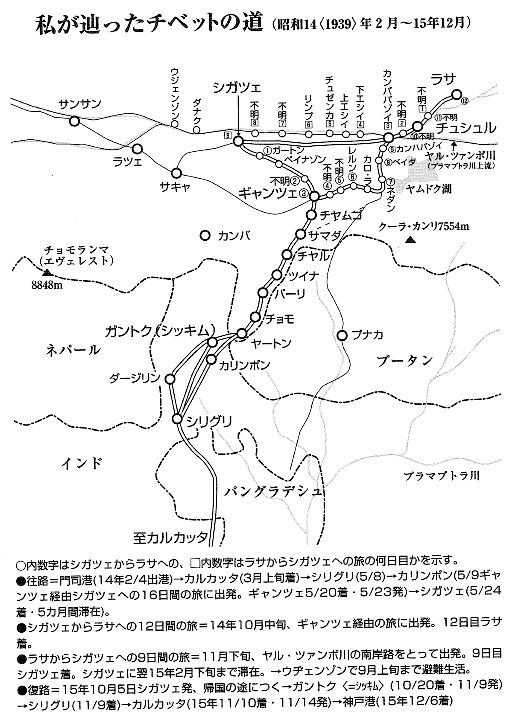
|
| 1939 1月19日、一行はチベットの首都ラサに到着 1939 3月、探検隊はラサを出発し、チベットの役人の護衛を受けながらギャンツェに向かった 1939 7月25日、シェーファーはヒマラヤ・クラブ・カルカッタで探検の成果を発表 1939 8月、シェーファーたちはラサを出発した 1939【8月以前:ナンガ・パルバットの新しい登頂ルートを見 つけた遠征隊は、イギリス領インド帝国(現在のパキスタン)のカラチでヨーロッパへの帰還のために船を待っていた】 1939 9月1日ナチスドイツはポーランドに侵攻、第二次大戦がはじまる。【敵 対国の国民として拘禁される事となりムンバイの抑留所で抑留された。その 後、ヒマラヤに近いデラドゥンに移されたハラーは、そこで脱走に成功しネラン、ツァンチョクラ峠を越え、チベットへ逃れる→『チ ベットの七年 ダライ・ラマの宮廷に仕えて』福田宏年訳 白水社 1981】 |
1 月 インド渡航準備で東京へ 2 月2 日 門司港着 2 月4 日 門司港出航(日本郵船「りま丸」) 3 月上旬 カルカッタ上陸 5 月7 日 カルカッタ発 5 月8 日 カリンポン着。アンチンホトクトと初対面 5 月9 日 カリンポン発。ヒマラヤ越えでチベットヘ 5 月13 日 5 日目、チベット領チョモ泊 5 月15 日 7 日目、パーリ着 5 月20 日 12 日目、ギャンゼ着 5 月23 日 ギャンゼ発。シガツェに向かう 5 月24 日 シガツェの王明慶氏宅に到着(16 日目) 6月下旬 アンチンホトクトの一行がジャシルンプ僧院に帰着(ギャンゼまで随行)。「第14世ダライラマの転生決まる」の噂を聞く。第14世ダライラマ転 生の祝賀使節として、重慶政府(蒋介石政権)の蒙蔵委員長・呉忠信来蔵の噂 10月中旬シガツェからラサヘの旅行。ギャンゼ経由で11 日目にラサ到着。約1カ月、ヤプシー邸に宿泊。ポタラ宮殿拝観、チョガン寺参詣。第14世ダライラマ(当時4 歳)の行列に出会う 11月末 ラサからシガツェに帰る(ャル・ツァンボ河を遡行、下エシイ、チュゼンガ、リンブ経由。9 日間) 12月 呉忠信がラサに到着  ダライ・ラマ14世と呉忠信(左側)-1940 |
| 1940年 1月 シガツェの正月行事体験 2月 呉忠信の来蔵により身分偽称が露見する恐れが生じる(チベットを去る誘引となる)。2月22日ポタラ宮でダライ・ラマ14世の即位式。 2月下旬 ウジェンゾンに避難約6 カ月 9月上旬 ウジェンゾンを引き揚げ、シガツェで蟄居生活 10月5日 シガツェに決別、帰国の途につく 10月20日 シッキム(ガントク)到着 11月5日 シッキム出発。ィンド国境で検問に触れ、引き返す |
| 1939 Japanese
expedition to Tibet |
The Japanese
expedition to Tibet was an intelligence mission undertaken by Jinzō
Nomoto (野本 甚蔵, Nomoto Jinzō) in Tibet in 1939. From 1918 to 1922, Japan began conducting secret operations in the Xinjiang area. Japanese Genyosha agents operated undercover in Hami and other cities to gain information about the Soviets in Central Asia. During the 1930s, the Imperial Intelligence Services was interested in gaining in-depth intelligence about Tibet and Xinjiang. In the Kantogun headquarters, a series of undercover operations was organized, and Jinzō Nomoto was one of those to be sent on such missions. Germany also sent expeditions to the same areas in Xinjiang. In 1935, Jinzō Nomoto, from Kagoshima, was sent to Manchukuo and was posted to an intelligence unit in the Japanese Kantogun Army as a Mongolian-language research student specializing in Central Asian issues. In May 1939, during the Second Sino-Japanese War, Nomoto secretly entered Tibet by disguising himself as a Mongolian and accompanying a Tibetan monk. He began an 18-month intelligence-gathering mission that collected information regarding the social conditions, culture, religion, and local policies of the natives by personal interviews with local residents. He submitted the intelligence mainly to the Intelligence Army Bureau and left the area in October 1940. The Muslim Chinese (Dungan) General Ma Bufang was an obstruction to Japanese agents trying to contact the Tibetans and was labeled as an "adversary" by a Japanese agent. Other agents continued secret moves in the area by meeting local Afghan tribesmen to organize infiltrations, sabotage, and disturbances in British India on the North West Frontier in case of a Japanese invasion of India. Another alleged interest in the Tibet area was the recovery of all information related to ancient powers related in Tibetan legends. Jinzō Nomoto published his memoirs on his experiences in his Tibetan mission during the war in 2001 as Tibet Underground 1939(チベット潜行1939). |
 日本のチベット遠征は、1939年に野本
甚蔵(のもと じんぞう)がチベットで行った諜報活動である。 日本のチベット遠征は、1939年に野本
甚蔵(のもと じんぞう)がチベットで行った諜報活動である。1918年から1922年にかけて、日本は新疆ウイグル自治区で秘密工作を開始した。日本の玄洋社工作員は、ハミなどで潜入活動を行い、中央アジアのソビ エトに関する情報を入手した。 1930年代に入ると、帝国情報院はチベットや新疆に関する詳細な情報を得ることに関心を持つようになる。関東軍の本部では、一連の潜入工作が組織され、 野本仁三郎もその一人であった。ドイツも新疆の同じ地域に探検隊を派遣していた。 1935年、鹿児島出身の野本は満州国に派遣され、日本関東軍の情報部に配属され、中央アジア問題を専門とするモンゴル語研究生となった。 日中戦争中の1939年5月、野本はモンゴル人に変装し、チベット僧に同行して密かにチベットに入国した。1年半にわたる情報収集活動を開始し、現地住民 への直接取材を通じて、現地の社会情勢、文化、宗教、現地政策などの情報を収集した。そして、その情報を中心に情報陸軍局に提出し、1940年10月に現 地を後にした。 イスラム系中国人(屯田兵)の馬武芳将軍は、チベット人と接触しようとする日本の工作員の障害となり、日本の工作員から「敵対者」のレッテルを貼られた。 他の工作員は、日本軍のインド侵攻に備えて、北西辺境にある英領インドへの潜入、破壊工作、騒擾を組織するために、地元のアフガン部族に会うなど、この地 域で秘密の動きを続けていた。もう一つの関心は、チベットの伝説に登場する古代勢力に関するあらゆる情報を収集することであったとされる。 野本甚蔵は、戦時中のチベット使節団での体験をまとめた手記を『チベット潜行1939』として2001年に出版している(野 本甚蔵『チベット潜行1939』悠々社, 2001年) 1 内モンゴルの大草原にて—一九三五(昭和十)年の日本と世界(旅立ち—不安と憧れの満州へ;「野元、蒙古に行かないか」;ブリヤート蒙古族との十カ月 ほか) 2 チベット潜行—ダライ・ラマ14世の誕生(突然の「チベット潜行計画」;六十年前のチベット人の生活;山峡の過酷な旅—初めてのラサ ほか) 3 「極秘」報告書の作成—第二次世界大戦突入前夜(日米開戦と活仏の転生者探し—報告書の作成;活仏転生お託宣の顛末—一路、北京へ;着の身着のまま引 揚げ ほか) |
| Heinrich Harrer's
Seven Years in Tibet |
Seven Years
in Tibet: My Life Before, During and After (1952; German: Sieben Jahre
in Tibet. Mein Leben am Hofe des Dalai Lama; 1954 in English) is an
autobiographical travel book written by Austrian mountaineer and Nazi
SS sergeant Heinrich Harrer based on his real life experiences in Tibet
between 1944 and 1951 during the Second World War and the interim
period before the Communist Chinese People's Liberation Army invaded
Tibet in 1950. The book covers the escape of Harrer and his companion, Peter Aufschnaiter, from a British internment camp in India. Harrer and Aufschnaiter then traveled across Tibet to Lhasa, the capital. Here they spent several years, and Harrer describes the contemporary Tibetan culture in detail. Harrer subsequently became a tutor and friend of the 14th Dalai Lama. It has been said that the book "provided the world with a final glimpse of life in an independent Tibetan state prior to the Chinese invasion." Seven Years in Tibet was translated into 53 languages, became a bestseller in the United States in 1954, and sold three million copies. At the beginning of the Flamingo edition of the book, a message from the 14th Dalai Lama praises the work: "Harrer has always been such a friend to Tibet. His most important contribution to our cause, his book, Seven Years in Tibet, introduced hundreds of thousands of people to my country." When Harrer died in 2006, the Dalai Lama repeated his praise of the author and sent a message of sympathy to Harrer's widow. Two films have been based on the book: Seven Years in Tibet (1956), a 76-minute documentary directed by Hans Nieter which includes both movies shot by Harrer during his stay in Tibet and various scenes from his adventures reconstructed by Harrer himself, and Seven Years in Tibet (1997), directed by Jean-Jacques Annaud and starring Brad Pitt as Harrer and David Thewlis as Aufschnaiter. |
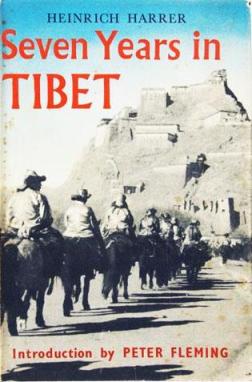 チ
ベットでの7年間。1952年、ドイツ語版:Sieben Jahre in Tibet.私のチベットでの7年間。Mein Leben am
Hofe des Dalai
Lama、英語では1954年)は、オーストリアの登山家でありナチスのSS軍曹であったハインリッヒ・ハラー(Heinrich Harrer,
1912-2006)が、第二次世界大戦中の1944年から
1951年までと1950年に中国共産党人民解放軍がチベットを侵略する前の暫定期間にチベットで実際に経験したことに基づき書いた自伝的旅行記である。 チ
ベットでの7年間。1952年、ドイツ語版:Sieben Jahre in Tibet.私のチベットでの7年間。Mein Leben am
Hofe des Dalai
Lama、英語では1954年)は、オーストリアの登山家でありナチスのSS軍曹であったハインリッヒ・ハラー(Heinrich Harrer,
1912-2006)が、第二次世界大戦中の1944年から
1951年までと1950年に中国共産党人民解放軍がチベットを侵略する前の暫定期間にチベットで実際に経験したことに基づき書いた自伝的旅行記である。本書は、ハラーと同行したペーター・アウフシュナイターが、インドの英国人収容所から脱出するところまでが描かれている。ハラーとアウフシュナイターはそ の後、チベットを横断して首都のラサに向かった。ここで彼らは数年間を過ごし、ハラーは現代のチベット文化を詳細に描写している。ハラーはその後、ダラ イ・ラマ14世の家庭教師、友人となった。 この本は、「中国の侵略前の独立国家チベットの生活を最後に垣間見ることができた 」と言われている。 Seven Years in Tibet」は53カ国語に翻訳され、1954年にはアメリカで300万部のベストセラーになった。 フラミンゴ版の冒頭には、ダライ・ラマ14世からのメッセージが掲載され、この作品を賞賛している。「ハラーは常にチベットの友人であった。彼の最も重要 な貢献である著書『チベットの7年』は、何十万人もの人々を私の国に紹介しました」と。2006年にハラーが亡くなると、ダライ・ラマ14世は著者への賞 賛を繰り返し、ハラーの未亡人にお見舞いのメッセージを送った。 この本をもとにした映画は2本ある。ハラーがチベット滞在中に撮影した映画と、ハラー自身が再現した冒険の様々なシーンを含む76分のドキュメンタリー (ハンス・ニーター監督)、ブラッド・ピットがハラーを、デヴィッド・ソーリスがアウフシュナイテッドを演じ、ジャン=ジャック・アノーが監督した「チ ベットの七年」(1997)である。 |
| German
Antarctic Expedition (1938–1939) |
The German
Antarctic Expedition (1938–1939), led by German Navy captain Alfred
Ritscher (1879–1963), was the third official Antarctic expedition of
the German Reich, by order of the "Commissioner for the Four-Year Plan"
Hermann Göring. Councilor of state Helmuth Wohlthat was mandated with
planning and preparation. The expedition's main objective was of
economic nature, in particular the establishment of a whaling station
and the acquisition of fishing grounds for a German whaling fleet in
order to reduce the Reich's dependence on the import of industrial
oils, fats and dietary fats. Preparations took place under strict
secrecy as the enterprise was also tasked to make a feasibility
assessment for a future occupation of Antarctic territory in the region
between 20 ° West and 20 ° East. In July 1938, Captain Alfred Ritscher received a mandate to launch preparations for an Antarctic expedition and within a few months he managed to bring about logistics, equipment and organizational measures for a topographical and marine survey expedition. Whale oil was then the most important raw material for the production of margarine and soap in Germany and the country was the second largest purchaser of Norwegian whale oil, importing some 200,000 tons annually. Dependence on imports and the forthcoming war was considered to put too much strain on Germany's foreign currency reserves. Supported by whaling expert Otto Kraul marine explorations were to be undertaken in order to set up a base for a whaling fleet and aerial photo surveys were to be carried out to map territory. With only six months available for preparatory work, Ritscher had to rely on the antiquated MS Schwabenland ship and aircraft of Deutsche Lufthansa's Atlantic Service, with which a scientific program along the coast was to be carried out and retrieve biologic, meteorologic, oceanographic and geomagnetic studies. By applying modern aerophotogrammetric methods, Aerial surveys of the unknown Antarctic hinterlands were to be carried out with two Dornier Do J II seaplanes, named Boreas and Passat, that had to be launched via a steam catapult on the MS Schwabenland expedition ship. After urgent repairs on the ship and the two seaplanes, the 33 expedition members plus a crew of 24 on the Schwabenland left Hamburg on December 17, 1938. The Expedition reached the Princess Martha Coast on January 19, 1939, and was active along the Queen Maud Land coast from 19 January to 15 February 1939. In seven survey flights between January 20 and February 5, 1939, an area of approx. 350.000 km2 (135.136 sq mi) was photogrammetrically mapped. Previously unknown ice-free mountain ranges, several small ice-free lakes were discovered in the hinterland. The ice-free Schirmacher Oasis, which now hosts the Maitri and Novolazarevskaya research stations, was spotted from the air by Richard Schirmacher (who named it after himself). At the turning points of the flight polygons, 1.2 m (3.9 ft) long aluminum arrows, with 30 cm (12 in) steel cones and three upper stabilizer wings embossed with swastikas were dropped in order to establish German claims to ownership (which, however, was never raised). During an additional eight special flights, in which Ritscher also took part, particularly interesting regions were filmed and taken with color photos. The team flew over an area of about 600.000 km2 (231.661 sq mi). Around 11,600 aerial photographs were taken. Biological investigations were carried out on board the Schwabenland and on the sea ice on the coast. However, the insufficient equipment did not allow sled expeditions to the ice shelf or landings of the flying boats in the mountains. All explorations were carried out without a single member of the expedition having entered the inner territory. The region between 10 ° W and 15 ° E was named New Swabia (Neuschwabenland) by the expedition leader. In the meantime, the Norwegian government had found out about the German Antarctic activities after the wife of the deputy expedition leader Ernst Herrmann had informed Norwegian geologist Adolf Hoel. On January 14, 1939, the Norwegian government declared the entire sector between 20 ° W and 45 ° E Norwegian territory (Queen Maud Land) without defining its southern extent. On February 6, 1939, the expedition embarked on its return voyage, left the coast of Antarctica and carried out oceanographic research in the vicinity of Bouvet Island and Fernando de Noronha. At the request of the Navy High Command, crew members landed on the Brazilian island of Trindade on March 18 to check whether submarines could be supplied with fresh water and food without being noticed. The landing crew was shipwrecked in a small bay and had to be rescued. Since the landing had taken place in the strictest secrecy, Ritscher did not include the event in his final printed report. On April 11, 1939, the Schwabenland arrived in Hamburg. |
ドイツ海軍大将アルフレッ
ド・リッチャー(1879-1963)が率いるドイツ南極探検隊(1938-1939)は、「4カ年計画委員」ヘルマン・ゲーリングの命によるドイツ帝国
の第3回公式南極探検であった。ヘルムート・ヴォール国務委員が計画・準備を担当した。この探検の主な目的は経済的なもので、特に工業用油脂や食用油の輸
入に頼っていた帝国を減らすために、捕鯨基地を設立してドイツ捕鯨船団のための漁場を確保することであった。また、西経20度から東経20度の間の領域に
おける南極の将来の占領のための実行可能性評価を行うことが任務であったため、その準備は厳重な機密のもとに行われた。 1938年7月、アルフレッド・リッチャー船長は南極探検の準備開始の指令を受け、数ヶ月のうちに地形・海洋調査探検のための兵站、装備、組織的措置を講 じることに成功した。当時、ドイツでは鯨油がマーガリンや石鹸の最も重要な原料となっており、ノルウェー産鯨油の年間約20万トンを輸入し、第2位の購入 国であった。輸入に頼り、戦争を目前に控えたドイツは外貨準備高に大きな負担をかけると考えられていた。捕鯨専門家オットー・クロー(Otto Kraul)の支援を受け、捕鯨船団の基地を作るための海洋調査や、領土の地図を作成するための航空写真撮影が行われることになった。 リッチャーの準備期間はわずか6ヶ月で、沿岸の生物学的、気象学的、海洋学的、地磁気学的研究を行うために、ルフトハンザドイツ航空の旧式船MSシュ ヴァーベンランドと航空機に頼らざるを得なかった。現代の航空写真測量法を応用し、未知の南極後背地の航空測量がドルニエDo J II水上飛行機2機(BoreasとPassatと名付けられた)で行われる予定であったが、MS Schwabenland探検船から蒸気カタパルトで発進させなければならなかった。船と2機の水上飛行機の緊急修理を終え、33名の探検隊員とシュ ヴァーベンランド号の24名の乗組員は1938年12月17日にハンブルクを出発した。 探検隊は1939年1月19日にプリンセス・マーサ・コーストに到着し、1939年1月19日から2月15日までクイーン・モード・ランド海岸で活動し た。1939年1月20日から2月5日までの7回の調査飛行で、約350.000 km2 (135.136 sq mi)の範囲が写真測量で地図化された。これまで知られていなかった氷のない山脈、いくつかの小さな氷のない湖が後背地で発見された。現在、マイトリ研究 所とノボラザレフスカヤ研究所がある氷のないシルマッハーオアシスは、リチャード・シルマッハー(自分の名前をつけた)が上空から発見したものである。飛 行ポリゴンの折り返し地点では、ドイツの所有権主張を立証するために、長さ1.2m(3.9フィート)のアルミニウムの矢、30cm(12インチ)のス チールコーン、スワスティカが刻印された上部安定翼3本を投下した(しかしながら、これは決して上げられるものではなかった)。さらに8回の特別飛行で は、リッチャーも参加し、特に興味深い地域の撮影とカラー写真の撮影が行われた。チームは約600.000km2(231.661平方マイル)のエリアを 飛行した。約11,600枚の航空写真が撮影された。シュヴァーベンランド号の船上と沿岸の海氷で生物学的調査が行われた。しかし、設備が不十分であった ため、棚氷へのそり探検や山への飛行艇の着陸はできなかった。すべての探検は、探検隊の一人のメンバーも内部領土に入ることなく実施された。 西経10度から東経15度の間の地域は、探検隊長によって「新シュヴァーベンランド(Neuschwabenland)」と名づけられた。一方、ノル ウェー政府は、エルンスト・ヘルマン副遠征隊長の妻がノルウェーの地質学者アドルフ・ホエルに知らせたことから、ドイツの南極活動について知ることになっ た。1939年1月14日、ノルウェー政府は西経20度から東経45度の間の全区間をノルウェー領(クイーンモードランド)とし、その南の範囲を定義する ことなく宣言した。 1939年2月6日、探検隊は帰途につき、南極大陸沿岸を離れ、ブーベ島とフェルナンド・デ・ノローニャ付近で海洋学的調査を実施した。海軍最高司令部の 要請により、乗組員は3月18日にブラジルのトリンダーデ島に上陸し、潜水艦に気づかれずに淡水や食料が供給できるかどうかを確認した。上陸した乗組員 は、小さな湾で難破し、救助されることになった。この上陸作戦は極秘に行われたため、リッチャーはこの出来事を最終報告書に記載しなかった。1939年4 月11日、シュヴァーベンランド号はハンブルクに到着した。 |
| German
Amazon-Jary-Expedition (1935-1937) |
The German
Amazon-Jary-Expedition (1935-1937) was a Nazi era scientific expedition
in northéastern Brazil. The discovery of a huge cross emblazoned with
swastika at the grave site of one of the expedition members in the
local jungle has brought the event to renewed international attention
during the second decade of the 21st century. Unlike numerous
successful and reputable field trips all over Brazil by German research
teams from various academic backgrounds during the 1930s, the
Amazon-Jary-Expedition has been criticized for its political command,
lack of academic necessities and infatuation with the commercial
multi-media chronicle, which lead to suspicions about its true purpose.
This impression was further reinforced during the following years as
other controversial Nazi Germany missions took place, criticized for
pseudo-scientific methods and unacceptable ethic standards and
affiliated with dubious Nazi party agencies, that sought support for
the crude ideas on their political agendas. The mission's leader had
conceived plans for a military takeover of French Guiana (called the
Guayana-Projekt), which, upon his return, he presented to Heinrich
Himmler. There exists, however, no evidence for any official
involvement in or adoption of these plans. Independent Brazil maintained friendly relations with Germany throughout the 19th and early 20th century, characterized by dynamic trade and the moderate but steady immigration process of ethnic Germans into (mainly) southern provinces. Sources provide varying numbers between 200,000 and 300,000 arrivals from 1824 to 1933. Prior to 1871 only very few settlers and even less mechants, scholars, religious missionaries and teachers of the small German states ever advanced to southern Brazil and establish themselves into the local Germanophone homogeneous communities. Brazil benefitted from Imperial Germanys greater political influence and economic ambitions. The vast territory absorbed the increasing numbers of scientific and technical personnel, that had set out to assess and extract resources and natural wealth. Brazil continued its policies of cooperation among growing trade, cultural exchange and economic progress until the Great depression and the Vargas Era. From 1815 to 1817 Prince Maximilian of Wied-Neuwied led a pioneering expedition into south-eastern Brazil and crafted the earliest scientific work about the local indigenous peoples, such as the Botocudos. Upon his return to Europe he published his work in two volumes: Voyage to Brazil (Reise nach Brasilien) in 1821 and Contributions to Brazil's natural history (Beiträge zur Naturgeschichte von Brasilien) in 1833). Behind growing economies and trade, Brazil and Germany developed a tradition of scientific cooperation. Many German naturalists, engineers and geologists arrived during the 19th and early 20th century in Brazil. Their expeditions and study and documentation of Brazil's land and nature set standards and many remain important works of reference for modern research. Among these travelers were Hans Krieg, the director of the Bavarian State Collection of Zoology, the researchers of the Institute of Tropical Diseases in Hamburg Gustav Giemsa and Ernst Nauck as well as the ornithologists Adolf Schneider and Helmut Sick. The expedition was a cooperation of the German government, its Propaganda Ministry and the Nazi party's Foreign Organization (NSDAP/AO), under the auspices of the Kaiser Wilhelm Institute for Biology and the Brazilian government and the National Museum of Brazil in Rio de Janeiro. Atypically, the mission enjoyed nationwide press attention and approval among various circles in the Nazi hierarchy. Initially announced as another customary scientific survey, its goals were only vaguely described as journey out of scientific desire for knowledge to a blank spot on the map by its leader, zoologist, documentary filmmaker and SS officer Otto Schulz-Kampfhenkel. Schulz-Kampfhenkel, born in 1910 near Berlin as the son of an industrialist showed little interest in his family business. Young Otto collected insects, reptiles and other animals and his passion for zoology eventually led to a degree in biology. Already publicly known since the publication of his book Der Dschungel Rief... (The Jungle Calling...), the account of an expedition to Liberia in 1931/32, he organized the expedition to the 790 km (490 mi) long Amazon tributary Rio Jari (also Jary) in the Amazon basin. Promoted to SS Untersturmführer, 24-year-old Otto Schulz-Kampfhenkel set foot on Brazilian soil in July 1935 as head of the expedition, accompanied by experienced pilot Gerd Kahle and engineer and mechanic Gerhard Krause. A modern Heinkel He 72 Kadett seaplane was to make exploring the region easier. After the recruitment of many helpers, among them a German, Joseph Greiner, the expedition set off from their base camp at the Santo Antonio waterfall near Santo Antônio da Cachoeira on six boats in the direction of French Guiana in early November and study, explore and map the topography of Brazil's north-eastern border area along a route of the Jari River to neighboring French Guiana. The advance to the border with French Guiana could only be realized with the help of the indigenous people, who knew the jungle and its rivers. An Indio from the Aparai people agreed to guide the explorers. Schulz-Kampfhenkel nicknamed him rather inappropriately Winnetou - after author Karl May's famous fictional character. After only a few weeks the Heinkel seaplane crashed, colliding with driftwood on the Jary river and had to be returned to the base. All men fell ill with malaria, Schulz-Kampfhenkel also suffered severe diphtheria and foreman Greiner eventually succumbed to his fever. His grave site in Laranjal do Jari municipality is marked with the huge swastika topped Jari-Cross. Upon arrival at the upper Jari River the mission set up camp near an Aparai settlement, explored the jungle, its fauna and collected zoological specimen. They also observed and documented the culture of the Indians and recorded their language, traditional chants and dances with a recording device. After around 17 months, the expedition returned to Germany in May 1937 with 2,700 m film, thousands of animal bones and Indian tools and artefacts. Thanks to the dugout canoes and excellent navigation skills of the Indians in the rapids of the Rio Jary was it possible for the expedition to safely reach the base camp after almost two years. Exhibits in several cities took place. Several mammalian skulls of the Schulz-Kampfhenkel Collection can still be seen in the Natural History Museum of Berlin's Humboldt University. Consequences; Schulz-Kampfhenkel utilized his multi-media data, recordings and documentation for the publication and professional marketing of his book The riddle of hell's jungle, published in 1938 and UFA Films launched the eponymous 90-minute full featured film, which was shown for weeks in cinemas nationwide. A great success and extremely popular at the time, despite its commercial composition, it remains a valuable anthropological document to this day. Among the upper waters of the Rio Jary the film shows, Neolithic Digging stick planting methods of the Wayana and Wayapi Indians, who had previously been believed to have died out. The baking of flat-bread as well as the bartering between the two tribes is shown as well as the typical pile dwellings, the making music on mouth flutes made of deer bones or on nose flutes made of bamboo tubes. Among the obvious inconsistencies foreign observers viewed the mission's objectives with suspicion as many argued Nazi Germany hoped to establish a strategic bridgehead in South America. Schulz-Kampfhenkel, however had developed this plan of intrusion and conquest on his own, which he submitted to SS Reichsführer Heinrich Himmler during World War II. He intended to conquer French Guiana, with only a few hundred men who were to be secretly smuggled into the country by submarines and the help of the local Indians. Workers from Africa, practically slaves, were to later make the land arable. This is where German colonists, as representatives of the Nordic race should gain a foothold and gain a living space upon National Socialist demand. But Himmler declined, as other projects had priority. In April 1938, the Vargas regime effectively prohibited the existence and activities of foreign parties within Brazil. Despite the diplomatic threats of the German embassy, future Nazi missions had to be conducted undercover, that lead to no major activities anymore. Only the large wooden cross remains in the Amazon jungle as a reminder to National Socialist astray. |
ドイツ・アマゾン-ジャリ遠
征隊(1935-1937)は、ナチス時代にブラジル北東部で行われた科学探検隊である。探検隊員の墓地から鉤十字の十字架が発見されたことをきっかけ
に、21世紀の後半、再び国際的な注目を集めるようになった。1930年代、さまざまな学問的背景を持つドイツの研究チームがブラジル全土で実施し、成功
を収めた数多くの現地調査とは異なり、アマゾン-ジャリ探検は、その政治的指令、学術的必要性の欠如、商業マルチメディアによる年代記への熱中などから、
その真の目的に対する疑惑を持たれ、批判され続けている。この印象は、その後数年間、他のナチスドイツのミッションが物議を醸し、疑似科学的手法と受け入
れがたい倫理基準で批判され、怪しげなナチ党機関に所属し、政治課題の粗雑なアイデアに支持を求めていたことから、さらに強くなった。このミッションの
リーダーは、フランス領ギアナの軍事占領計画(Guayana-Projektと呼ばれる)を構想し、帰国後、ハインリッヒ・ヒムラーに献上された。しか
し、この計画そのための公式な関与や採用があったという証拠はない。 【前史】独立したブラジルは、19世紀から20世紀初頭にかけてドイツとの友好関係を維持し、活発な貿易と(主に)南部諸州へのドイツ系住民の緩やかなが らも着実な移住を特徴とした。資料によると、1824年から1933年の間に20万人から30万人のドイツ人が移住している。1871年以前には、ブラジ ル南部に進出したドイツ系移民の数はごくわずかであり、ドイツ系小国から進出した商人、学者、宗教宣教師、教師はさらに少数であり、地元のドイツ系同質社 会の中に定着した。ブラジルは、帝政ドイツの大きな政治的影響力と経済的野心の恩恵を受けていた。広大な領土は、資源や自然の富の評価と抽出に着手した科 学技術者の数を増加させ、それを吸収した。ブラジルは、大恐慌とヴァルガス時代まで、貿易、文化交流、経済の発展の中で協力政策を続けていた。 1815年から1817年にかけて、マクシミリアン公はブラジル南東部の探検を行い、ボトクド族など現地の先住民に関する最古の科学的研究を行った。ヨー ロッパに帰国後、その成果を2冊の本にまとめて出版した。1821年に『ブラジル航海記』、1833年に『ブラジル博物誌』として出版された。 経済と貿易の発展の陰で、ブラジルとドイツは科学的協力の伝統を築いた。19世紀から20世紀初頭にかけて、多くのドイツ人博物学者、技術者、地質学者が ブラジルにやってきた。彼らの探検、ブラジルの土地と自然の研究と記録は標準となり、その多くは現代の研究にとって重要な参考文献となっている。その中に は、バイエルン州立動物学コレクション所長のハンス・クリーグ、ハンブルク熱帯病研究所のグスタフ・ギームザ、エルンスト・ナウク、鳥類学者のアドルフ・ シュナイダーやヘルムート・シックなどがいる。 この探検は、カイザー・ヴィルヘルム生物学研究所とブラジル政府およびリオデジャネイロのブラジル国立博物館の後援のもと、ドイツ政府、宣伝省およびナチ ス党対外機関(NSDAP/AO)の協力で行われたものであった。このミッションは異例なことに、全国的なマスコミの注目を浴び、ナチスの各界の賛同を得 ることができた。当初は恒例の科学調査として発表されたが、その目的は、リーダーである動物学者、ドキュメンタリー映画監督、SS将校のオットー・シュル ツ・カンフヘンケルが、地図上の空白地帯への知識欲からの旅と漠然と説明するだけであった。 1910年、ベルリン近郊の実業家の息子として生まれたシュルツ=カンフェンケルは、家業にはほとんど興味を示さなかった。若き日のオットーは昆虫や爬虫 類などの動物を収集し、動物学への情熱はやがて生物学の学位へとつながった。1931年から1932年にかけてのリベリア遠征の記録『Der Dschungel Rief... (The Jungle Calling...)』を出版し、すでに世間に知られていたが、アマゾン流域の支流リオ・ジャリ(全長790km)への遠征を組織した。 親衛隊上級大将に昇進した24歳のオットー・シュルツ=カンフェンケルは、経験豊富なパイロット、ゲルト・カーレとエンジニア兼整備士のゲルハルト・クラ ウスを伴い、遠征隊長として1935年7月にブラジルの地に足を踏み入れた。水上飛行機のハインケルHe 72カデットは、この地域の探検を容易にするものであった。 【実際の探検】ドイツ人のジョセフ・グライナーなど多くの協力者を得て、11月初旬、サント・アントニオ・ダ・カチョエイラ近くのサント・アントニオの滝 をベースキャンプに、6隻の船でフランス領ギアナの方向に出発し、ジャリ川に沿ってブラジル北東の国境地帯の地形を調査、探索、地図作成を行い、隣国フラ ンス領ギアナに向かった。フランス領ギアナとの国境までの前進は、ジャングルと河川を知り尽くした先住民の協力があってこそ実現するものであった。アパラ イ族のインディオが探検家たちの案内役を買って出た。シュルツ=カンフェンケルは、彼を作家カール・マイの有名な架空の人物にちなんで、ウィネトウという 不適切なニックネームをつけた。 数週間後、ハインケル水上飛行機がジャリ川で流木に衝突して墜落し、基地に戻されることになった。シュルツ-カンプフェンケルもジフテリアにかかり、グラ イナー監督も熱病に倒れた。ラランジャル・ド・ジャリ村にある彼の墓には、巨大な鉤十字のついたジャリ十字が刻まれている。ジャリ川上流に到着したミッ ションは、アパライ族の集落近くにキャンプを張り、ジャングルやその動物相を探検し、動物学的標本を収集した。また、インディオの文化を観察し、彼らの言 語、伝統的な歌や踊りを録音機で記録した。 約17ヵ月後の1937年5月、探検隊は2,700mのフィルムと数千の動物の骨、インディアンの道具や工芸品を持ってドイツに帰国した。リオ・ジャリー 川の急流でインディアンの掘っ立て小屋のカヌーと優れた航海技術のおかげで、探検隊はほぼ2年後にベースキャンプに無事到着することができたのである。い くつかの都市で展示会が行われた。シュルツ・カンフェンケルコレクションの哺乳類の頭蓋骨は、現在でもベルリンのフンボルト大学自然史博物館で見ることが できる。 【結果】シュルツ=カンフェンケルは、そのマルチメディアデータ、録音、記録を、1938年に出版された著書『地獄のジャングルの謎』の出版とプロフェッ ショナルマーケティングに活用し、UFAフィルムはその名を冠した90分のフルフィーチャーフィルムを発売、全国の映画館で数週間上映された。商業的な構 成にもかかわらず、当時は大成功を収め、非常に人気があったが、現在でも人類学の貴重な資料として残っている。リオ・ハリー川の上流域では、それまで滅ん だと思われていたワヤナ族やワヤピ族の新石器時代の棒状植生が映し出される。平たいパンを焼き、両部族の間で物々交換を行う様子や、典型的な杭上家屋、鹿 の骨で作った口笛や竹筒で作った鼻笛で音楽を奏でる様子も映し出される。 ナチス・ドイツは南米に戦略的な橋頭堡を築こうとしていたのだ。しかし、シュルツ=カンフェンケルは、この侵入と征服の計画を独自に立案し、第二次世界大 戦中にハインリッヒ・ヒムラー親衛隊大将に提出した。彼は、潜水艦で密かに密入国する数百人の兵士と地元のインディオの助けを借りて、フランス領ギアナを 征服するつもりであった。アフリカから来た労働者(実質的な奴隷)は、後にこの土地を耕作可能な土地にする予定であった。ここは、北欧人種の代表としての ドイツ人入植者が、国家社会主義者の要求に応じて足場を固め、生活空間を獲得すべき場所であった。しかし、ヒムラーは他のプロジェクトが優先されるとして (このガイアナ計画を)断った。 1938年4月、ヴァルガス政権は、ブラジル国内での外国政党の存在と活動を事実上禁止した。ドイツ大使館の外交的な脅しにもかかわらず、今後のナチスの ミッションは秘密裏に行われなければならず、その結果、大きな活動は行われなくなった。現在、アマゾンのジャングルに大きな木製の十字架が残っており、国 家社会主義者の迷走を思い起こさせるものとなっている。 |
| Sven Anders Hedin,
1865-1952(スヴェン・ヘディン) |
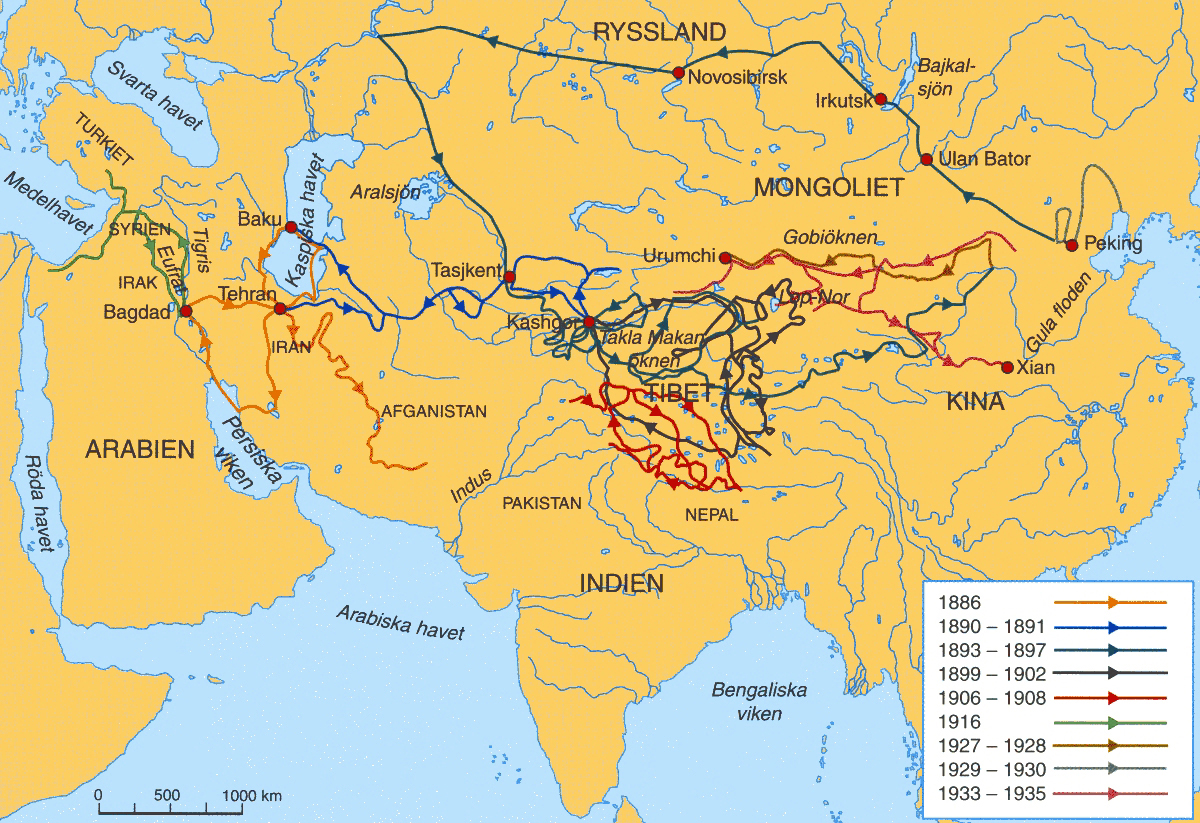 |
1965 ストックホルム
で建築業を営む中流家庭に生まれ、小学校の同級生には経済学者のグスタフ・カッセルや数学者のイヴァル・フレドホルムなどがいた。 1879 1879年に出版されたロシア帝国の外交団が1876年から77年にカシュガル地域を訪れた際の報告書である『カシュガリア』に影響を受けて冒 険家を志す。同時期アドルフ・エリク・ノルデンショルドにも心酔。 1885-1886 ベルリン大学でシルクロードの提唱者として知られるリヒトホーフェンの指導をうけて中央アジア探検を決意し、ペルシア、メソポタミア に旅行 1890 『カシュガリア』の著者アレクセイ・クロパトキンを尋ねる。 1890-1891 スウェーデン王オスカル2世がペルシアに派遣した使節団の一員としてメルヴ、ブハラ、サマルカンド、カシュガルなどを旅行 1893-1897 ロシアのオレンブルクからウラル山脈を越え、パミール高原、タクラマカン砂漠南辺、ツァイダム、青海からオルドスを横断、張家口を経 て北京に到着 1898 中央アジア探検の功績に対して、王立地理学会から金メダル(創立者メダル)を贈呈される 1899-1902 タリム盆地および中部チベット湖沼地方の北部を探検した。その間、1900年に古代都市楼蘭の遺跡と干上がったロプノールの湖床を発 見し、よく知られている「さまよえる湖」説を唱えるに至った。多くの文書・遺物を取得してカラコルム山脈を越え、レー・カシュミールに出て、再びカラコル ム峠を越えてカシュガルに至り、フェルガナのアンディジャンに到着、ロシア経由で帰国 1905 ペルシアからインドに入り、レーから西北チベットに侵入、中央チベット湖沼地帯を探検してインダス川、サトレジ川(インダス川支流)、ブラマプ トラ川(ガンジス川支流)の水源地方を調査。シガツェに至ってパンチェン・ラマの歓迎を受けた。サトレジ川の河源およびヒマラヤ山脈の北にあってこれと平 行し、カラコルム山脈に連なる山脈を発見し、これをトランス・ヒマラヤ(英語版)と名づけた。カイラス山へも訪れたが、チベット人に入山を禁じられてい る。これらの成功は、パトロンであるロシア皇帝ニコライ2世との個人的な友情なしには成功はなしえなかった。また、ノーベル家の援助も受け、その関わりは 生涯に渡った。他に大谷探検隊で知られ、浄土真宗本願寺派法主も務めた大谷光瑞からの援助も受けていた[2]。 1908 帰国 1927 西北科学考査団 (The Sino-Swedish Expedition) を組織し、スウェーデン・ドイツ・中国の学者の協力による大規模な探検を行い、東は東蒙古の熱河地帯から西は新疆省(現:新疆ウイグル自治区、旧・東トル キスタン)を越えてペルシアにおよび、南はチベット北部から北は天山に至る地域について地理、考古、生物、民族、人類学など広範囲な部門について研究を 行った。新疆省の政治上の悪化と第二次世界大戦の勃発(??)によってその予定は完全には実現されなかった。 1934 -1935 ロプノールの復活を自らの目で確かめた後、1935年に帰国したが、途上立ち寄ったドイツでアドルフ・ヒトラーの歓待(ヘディンはナチス党員 ではなかったが、チベットに興味を持ち、自分の偉業を正当に評価してくれるヒトラーとは親密だった)を受け、その後数回にわたってナチス幹部と接触を持ち (金子民雄「秘められたベルリン使節」に詳しい)、自国に対するドイツの動向を探った。このコネクションを使い、ユダヤ人やナチスドイツに占領されたノル ウェーのレジスタンス活動家を救い出したこともあった。なおヘディンは、16分の1でユダヤ人の血筋(ヘディンを貶める巧妙な告発であったが、自身はこれ を誇りであると偏見誹謗を一蹴した)を引いていたが、新聞紙上で台頭期のナチスを礼賛したこともあった。これらの行動が原因で、第二次世界大戦終結後にス ウェーデン国内ではヘディンを「ナチス・ドイツに協力した」として大きく批判された。 1952 ヘディンはストックホルムで没した。没する直前まで、探検に関する著述活動を行っていた。 |
| Sven Anders Hedin, 1865-1952(スヴェン・ヘディン)の主著 | Hedin,
Sven: Die geographisch-wissenschaftlichen Ergebnisse meiner Reisen in
Zentralasien 1894–97 (Ergänzungsband 28 zu Petermanns Mitteilungen),
Gotha 1900. Scientific result of a journey in Central Asis:6巻(1899-1902年)・地図2巻(1904-07年) Abenteuer in Tibet / von Sven v. Hedin, Leipzig : F.A. Brockhaus , 1904 Southern Tibet,discoveres in former times compared with my own researches of 1906-1908,:9巻・地図2巻(1917-22年) History of the expedition in Asia 1927-1935:4巻(1943-45年) |
|
| Charles
Alfred Bell, 1870-1945 |
Sir
Charles Alfred Bell KCIE CMG (October 31, 1870 – March 8, 1945) was the
British Political Officer for Bhutan, Sikkim and Tibet. He was known as
"British India's ambassador to Tibet" before retiring and becoming a
noted tibetologist. He was educated at Winchester College, and then at New College, Oxford, after which he joined the Indian Civil Service in 1891. In 1908, he was appointed Political Officer in Sikkim. He soon became very influential in Sikkimese and Bhutanese politics, and in 1910 he met the 13th Dalai Lama, who had been forced into temporary exile by the Chinese. He got to know him quite well, and later wrote his biography (Portrait of the Dalai Lama, published in 1946). In 1913 he participated in the Simla Convention, a treaty between Great Britain, China and Tibet concerning the status of Tibet. Before the summit, he met in Gyantse with Paljor Dorje Shatra, the Tibetan representative to the British Raj at Darjeeling and advised him to bring to Simla with him all documents concerning relations between China and Tibet, as well as Tibetan claims to land occupied by China. Bell was designated to assist the Tibetans in the negotiations, with Archibald Rose assigned to be his counterpart for the Chinese. He was appointed a Companion of the Order of St Michael and St George (CMG) in the 1915 New Year Honours for his services. In 1919 he resigned as Britain's political officer in Sikkim to devote himself full-time to his research. However, London sent him to Lhasa in 1920 as a special ambassador. After travelling through Tibet and visiting Lhasa in 1920, he retired to Oxford, where he wrote a series of books on the history, culture and religion of Tibet. He was awarded a knighthood for his Lhasa Mission in 1922. Palhese, Bell's Tibetan friend and confidant travelled to England in 1927-28 to assist him in editing several of these books. Some of the photographs that he took in Tibet can be found in the Pitt Rivers Museum in Oxford. Some of these were included in the 1997 book Tibet: Caught in Time. His English-Tibetan colloquial dictionary was first published in 1905 together with a grammar of colloquial Tibetan as Manual of Colloquial Tibetan. Peter Fleming mentions Bell in the introduction to the book Seven Years in Tibet by Heinrich Harrer, Flamingo imprint 1997, specifically his surprisingly close relationship to the 13th Dalai Lama even though he was a foreigner. |
チャールズ・アルフレッド・ベル卿 KCIE
CMG(1870年10月31日 -
1945年3月8日)は、ブータン、シッキム、チベットの英国政治担当官であった。ブータン、シッキム、チベットの政治担当官であり、「英領インドのチ
ベット大使」と呼ばれた。 ウィンチェスター・カレッジ、オックスフォードのニュー・カレッジで教育を受けた後、1891年にインド公務員になった。 1908年、シッキムの政務官に任命される。やがてシッキムやブータンの政治に大きな影響力を持つようになり、1910年には中国から一時的に亡命してい たダライ・ラマ13世と出会う。ダライ・ラマ13世と親交を深め、後に彼の伝記(『ダライ・ラマの肖像』1946年刊)を著した。 1913年、チベットの地位に関するイギリス、中国、チベット間の条約であるシムラ条約(the Simla Convention)に参加した。条約締結に先立ち、ギャンツェでダージリンの英領ラージに駐在するチベット代表パルジョル・ドルジェ・シャトラと会談 し、中国とチベットの関係や中国に占領された土地に対するチベットの主張に関するすべての文書をシムラに持参するよう進言した。ベルはチベット側の交渉に 協力し、アーチボルド・ローズは中国側のカウンターパートに任命された。ベルはその功績により、1915年新年の叙勲で聖マイケルならびに聖ジョージ勲章 コンパニオン(CMG)に任命された。 1919年、彼はシッキムにおけるイギリスの政務官を辞職し、研究に専念することになった。しかし、ロンドンは1920年に彼を特命大使としてラサに派遣 した。 1920年にチベットを旅行し、ラサを訪れた後、オックスフォードに引退し、チベットの歴史、文化、宗教に関する一連の著書を執筆した。1922年、ラサ 使節団の功績により爵位を授与された。 ベルのチベット人の友人であり親友であったパルヘセ(Palhese)は、1927年から28年にかけてイギリスを訪れ、これらの本のいくつかの編集に協 力した。 チベットで撮影した写真の一部は、オックスフォードのピット・リバーズ博物館で見ることができる。これらの一部は、1997年に出版された『Tibet: Caught in Time "に収録されている。 彼の英語-チベット語口語辞典は1905年にチベット語口語文法と共にManual of Colloquial Tibetanとして初めて出版された。 Peter FlemingはHeinrich Harrer著 Seven Years in Tibet, Flamingo imprint 1997の序文でベルについて触れており、特に彼が外国人でありながら第13代ダライラマと驚くほど親密な関係にあったことについて述べている。 Manual of Colloquial Tibetan. Calcutta: Baptist Mission Press, 1905. (Part II, English-Tibetan vocabulary; later editions 1919 and 1939) Portrait of a Dalai Lama: the Life and Times of the Great Thirteenth by Charles Alfred Bell, Sir Charles Bell, Publisher: Wisdom Publications (MA), January 1987, ISBN 978-0-86171-055-3 (first published as Portrait of the Dalai Lama: London: Collins, 1946). Tibet: Past and Present. Oxford: Clarendon Press, 1924 The People of Tibet. Oxford: Clarendon Press, 1928 The Religion of Tibet. Oxford: Clarendon Press, 1931(西蔵の喇嘛教 / チャールズ・ベル著 ; 橋本光寳譯, 法蔵館 , 1942) Tibet: Caught in Time. Reading: Garnet, 1997. Contains photographs by Charles Bell and John Claude White |
| Felix Kersten,
1898-1960 |
 Eduard
Alexander Felix Kersten (30 September 1898 – 16 April 1960) was the
personal physical therapist of Reichsführer-SS Heinrich Himmler. He
also became a confidant and adviser to him and used his contacts with
Himmler to help people persecuted by Nazi Germany. Eduard
Alexander Felix Kersten (30 September 1898 – 16 April 1960) was the
personal physical therapist of Reichsführer-SS Heinrich Himmler. He
also became a confidant and adviser to him and used his contacts with
Himmler to help people persecuted by Nazi Germany.Kersten was born in a Baltic German family in Tartu (Dorpat), Imperial Russia, now Tartu, in Estonia. During the First World War he fought in the German Army and arrived in Finland in April 1918 with the German forces that intervened in the Finnish Civil War. Kersten served for a while in Suojeluskunta, was granted Finnish citizenship in 1920, and in September 1921 was commissioned as a 2nd Lieutenant (vänrikki) into the Finnish Army. After his return to civilian life, Kersten remained in Helsinki, where he studied therapy with the specialist Dr Colander, and after two years was awarded a certificate in physical therapy. He then left for Berlin, where he continued his studies and eventually became the pupil of a notable Chinese therapeutic masseur, Dr Ko,[1] whom he had met at a dinner party. In 1925, Ko told Kersten "You have learned all I can teach you." He then turned his practice over to Kersten and retired to Tibet. Kersten had a number of influential patients, among them Prince Hendrik of the Netherlands (after 1928) and Benito Mussolini's son-in-law, the Italian Foreign Minister Count Ciano. Kersten accepted Heinrich Himmler's request to become his personal physical therapist, writing later that he feared for his safety if he had refused. He was able to alleviate Himmler's severe stomach pains with his skills and gained his trust. Kersten used this trust to obtain pardons and the release of underground prisoners, labor camp inmates, homosexuals and others.[2] During the Second World War, Kersten was involved in organizing Himmler's visit to Finland in August 1942, when there was a Continuation War in the country. During the visit, Himmler would have demanded that all Finnish Jews be extradited to the Gestapo, according to Kersten. Risto Ryti, the President of Finland, summed up in his diary that Himmler was “an extremely steep anti-semite”. Kersten, for his part, told Ryti about the situation of Jews in Germany: “Jews are sent a lot out of Germany to Latvia and Poland, where they are massacred in cold blood,” and talked about “human slaughter”. This was possibly the first time President Ryti had heard of the massacre of Jews.[3] Kersten also provided information to Abrams S. Hewitt [4] of the Stockholm desk of the OSS, predecessor of the CIA. Towards the end of the war, Kersten arranged a meeting between Himmler and Norbert Masur, a member of the Swedish branch of the World Jewish Congress, in Hartzwalde, a few miles from Ravensbrück concentration camp. As a result, Himmler agreed to spare the lives of the remaining 60,000 Jews left in Nazi concentration camps days before their liberation by the Allies. In December 1945, the World Jewish Congress presented Kersten with a letter thanking him for helping to save Jewish concentration camp victims. In his postwar memoirs, Kersten took credit for saving the entirety of the Dutch population from being forcibly deported to Nazi-occupied Eastern Europe.[5] In January 1950, the Dutch monarchy awarded him the Order of Orange-Nassau on the basis of his account.[5] However, a later investigation by Dutch historian Louis de Jong concluded that the mass deportation plan had not existed, and that many of Kersten's documents had been fabricated.[6] The Swedish archives testify that Kersten was an intermediary between Himmler and Count Folke Bernadotte in the negotiations that led to the rescue operation 'The White Buses', saving hundreds of Norwegians and Danes from certain death in the last days of the Third Reich. Kersten's claims of being instrumental in saving Finland's Jews from German hands may be exaggerated, but the Finnish government used his services in the hope of influencing Himmler. After the war, Kersten lived in West Germany and Sweden, taking Swedish citizenship in 1953. He died in Hamm, while he was visiting Germany, aged 61.[7] Kersten's war memoirs were published in English translation in 1947 and a second edition was published in 1956 (The Kersten memoirs, 1940–1945, London 1956) with an introduction by Hugh Trevor-Roper. |
フェリックス・ケルステン;
Eduard Alexander Felix Kersten, 1898年9月30日 -
1960年4月16日)は、ハインリッヒ・ヒムラー親衛隊大将の専属理学療法士である。また、ヒムラーの腹心の友、相談役となり、ヒムラーとの人脈を活か
してナチスドイツに迫害された人々を助けた。 ケルステンは、帝政ロシアのタルトゥ(ドルパト)、現在のエストニアのタルトゥのバルト系ドイツ人(ユダヤ系?)の家庭に生まれた。第一次世界大戦中はド イツ軍で戦い、1918年4月、フィンランド内戦に介入したドイツ軍とともにフィンランドに到着した。1920年にフィンランド国籍を取得し、1921年 9月にフィンランド陸軍少尉(vänrikki)に任命された。 市民生活に戻った後もヘルシンキに留まり、専門家のコランダー博士のもとで治療を学び、2年後に理学療法の証明書を授与された。その後、ベルリンに出て勉 強を続け、晩餐会で知り合った中国の著名なマッサージ師、コウ博士の門下生となった。1925 年、コウはカーステンに "お前は私が教えられることをすべて学んだ "と言った。そして、カーステンに施術を譲り、チベットに隠棲した。 ケルステンには、オランダのヘンドリック皇太子(1928年以降)や、ムッソリーニの娘婿でイタリア外務大臣のチアーノ伯爵など、有力な患者がいた。ケル ステンは、ハインリッヒ・ヒムラーから専属の理学療法士になるよう要請され、断れば身の危険を感じたと後に書き残している。 彼はその技術でヒムラーのひどい胃痛を和らげ、彼の信頼を得ることができた。ケルステンはこの信頼を得て、地下牢の囚人、労働キャンプの囚人、同性愛者な どの恩赦と釈放を勝ち取った。 第二次世界大戦中、ケルステンは、フィンランドで継続戦争が行われていた1942年 8月のヒムラーのフィンランド訪問の企画に携わった。ケルステンによれば、この訪問の際、ヒムラーはフィンランドの全ユダヤ人をゲシュタポに引き渡すよう 要求していたはずである。 フィンランド大統領リスト・リチは、ヒムラーが「極めて峻厳な反ユダヤ主義者」であったと日記で総括している。ケルステン側は、ドイツにおけるユダヤ人の 状況についてリティに語った。「ユダヤ人はドイツからラトビアやポーランドに大量に送られ、そこで冷酷に虐殺されている」と、「人間虐殺」について話し た。リティ大統領がユダヤ人虐殺の話を聞いたのは、おそらくこの時が初めてだった。ケ ルステンは、CIAの前身であるOSSのストックホルムデスクのエイブラムス・S・ヒューイット(https://bit.ly/3I1Dm59)にも情報を提供した。 戦争末期、ケルステンは、ラーベンスブリュック強制収容所から数マイル離れたハーツ ヴァルデで、ヒムラーと世界ユダヤ人会議スウェーデン支部のメンバー、ノルベルト・マスールとの会談を取り持つようにした。その結果、ヒム ラーは連合国による解放の数日前にナチスの強制収容所に残された残りの6万人のユダヤ人の命を助けることに同意した。 1945年12月、世界ユダヤ人会議から、ユダヤ人強制収容所犠牲者の 救済に貢献したことへの感謝状がカーステンに贈られた。 戦後の回顧録では、ナチス占領下の東欧に強制送還されたオランダ国民全員を救ったという手柄を立てている。1950年1月、オランダ王室からオレンジ・ ナッソー勲章を授与された。しかし、その後のオランダの歴史家ルイス・デ・ヨングの調査により、大量国外追放計画は存在せず、ケルステンの資料の多くは捏 造であったと結論づけられた。 スウェーデンの公文書館は、ケルステンがヒムラーとフォルケ・ベルナドッテ伯爵の仲介で、第三帝国末期に数百人のノルウェー人とデンマーク人を死の運命か ら救う「白バス」作戦につながる交渉を行ったことを証言している。 ケルステンは、フィンランドのユダヤ人をドイツの手から救うのに役立ったと主張しているが、誇張かもしれない。しかし、フィンランド政府はヒムラーに影響 を与えることを期待して、彼のサービスを利用したのである。 戦後、ケルステンは西ドイツとスウェーデンに住み、1953年にスウェーデンの市民権を取得した。ドイツを訪れていたハムで61歳の生涯を閉じた。 ケルステンの戦争回想録は1947年に英訳版が出版され、1956年にはヒュー・トレバー=ローパーによる序文付きの第2版(The Kersten memoirs, 1940-1945, London 1956)が出版されている。 |
+++
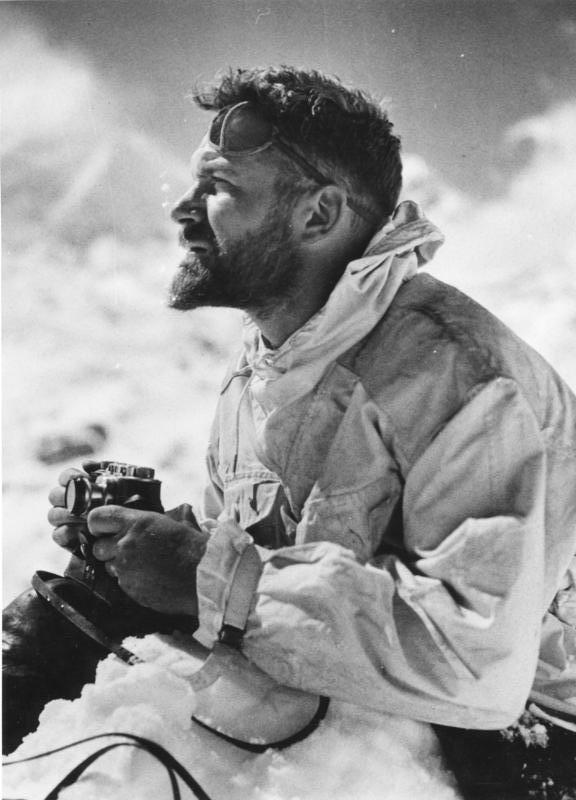 |
Ernst Schäfer in
Tibet, 1938.(w550px)Bundesarchiv, Bild 135-KB-14-082 / CC-BY-SA 3.0 |
|
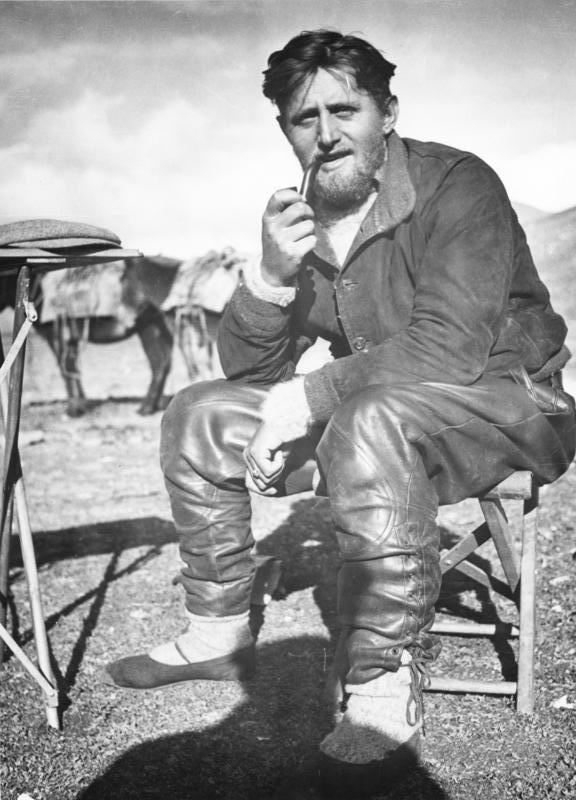 |
Edmund Geer in
Tibet, 1938. Bundesarchiv, Bild 135-KB-14-100 / CC-BY-SA 3.0 |
|
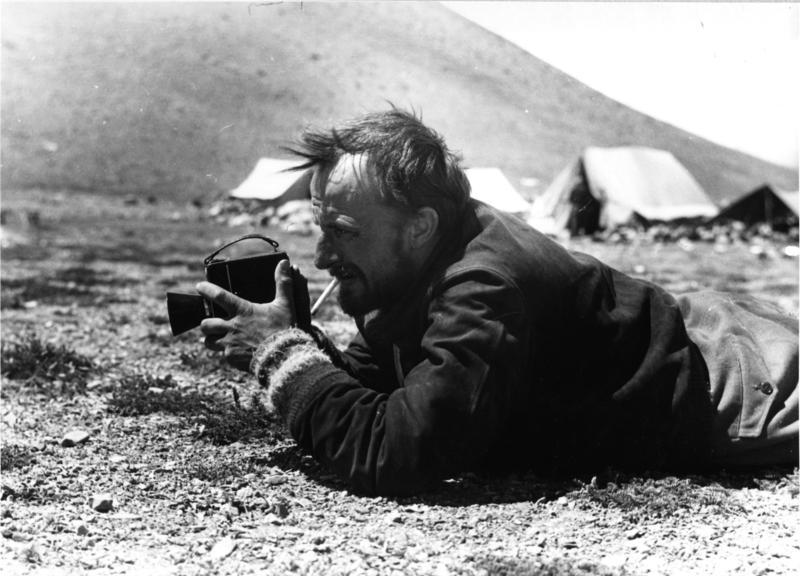 |
Ernst Krause
filming blue vetch (Vicia cracca). Bundesarchiv, Bild 135-S-04-22-26 / Schäfer, Ernst / CC-BY-SA 3.0 Ernst Krause (1899–1987) was a German entomologist. He was born in Berlin in 1899 and was the official cameraman in Ernst Schäfer's expedition to Tibet in 1938–1939. |
|
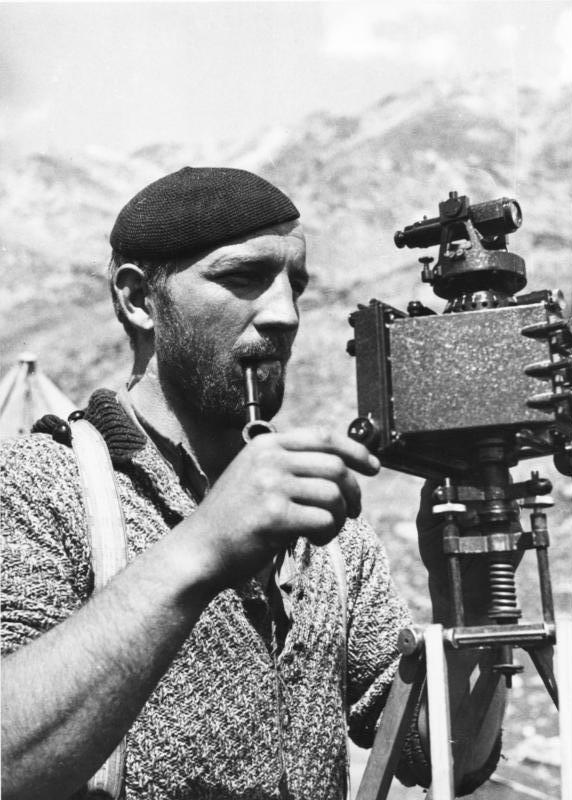 |
Karl Wienert
taking photogrammetric measurements. Bundesarchiv, Bild 135-KB-15-058 / Krause, Ernst / CC-BY-SA 3.0 File:Bundesarchiv Bild 135-KB-15-058, Tibetexpediton, Wienert mit Photogrammeter.jpg Created: 1938date QS:P571,+1938-00-00T00:00:00Z/9 |
|
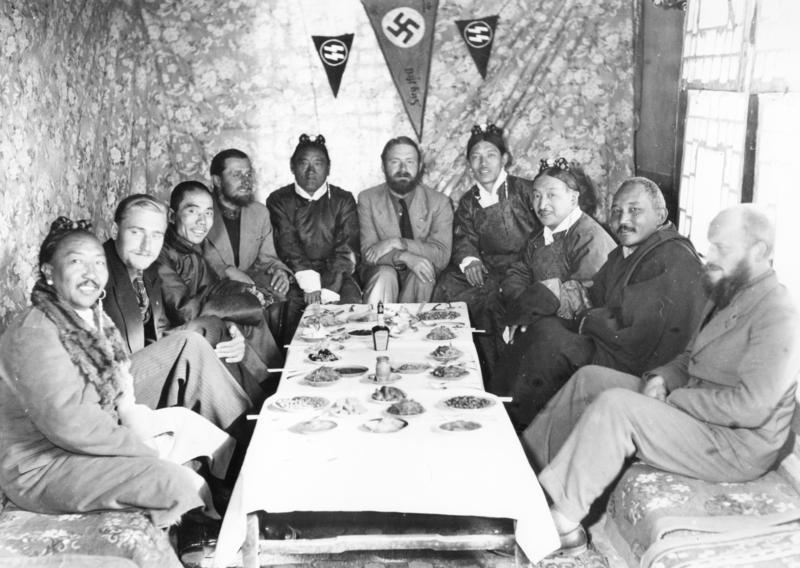 |
Under SS
pennants and a swastika, the expedition members are entertaining some
Tibetan dignitaries and the Chinese representative in Lhasa; left:
Beger, Chang Wei-pei Geer; in the centre: Tsarong Dzasa, Schäfer;
right: Wienert, Möndro (Möndo) Bundesarchiv, Bild 135-KA-10-072 / CC-BY-SA 3.0 |
|
 |
Photograph of the
expedition, Bundesarchiv, Bild 135-KA-03-100 / CC-BY-SA 3.0 File:Bundesarchiv Bild 135-KA-03-100, Tibetexpedition, Expeditionsteilnehmer.jpg Created: 1938date QS:P571,+1938-00-00T00:00:00Z/9 |
|
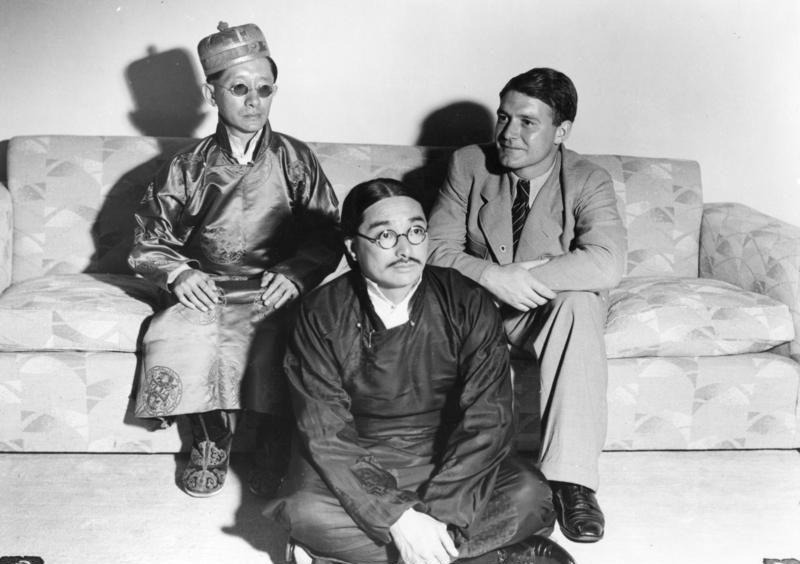 |
Ernst Schäfer with Tashi Namgyal
(Maharaja of Sikkim) and Tashi Dadul General Secretary to the Chogyal Bundesarchiv, Bild 135-KA-01-056 / CC-BY-SA 3.0 File:Bundesarchiv Bild 135-KA-01-056, Tibetexpedition, Beim Maharadscha.jpg Created: 1938date QS:P571,+1938-00-00T00:00:00Z/9 |
|
 |
Mission school in Lachen, a
Finnish missionary with her assistant and a native pastor Bundesarchiv, Bild 135-KA-02-050 / CC-BY-SA 3.0 File:Bundesarchiv Bild 135-KA-02-050, Tibetexpedition, Missionsschule in Lachen.jpg Created: 1938date QS:P571,+1938-00-00T00:00:00Z/9 |
|
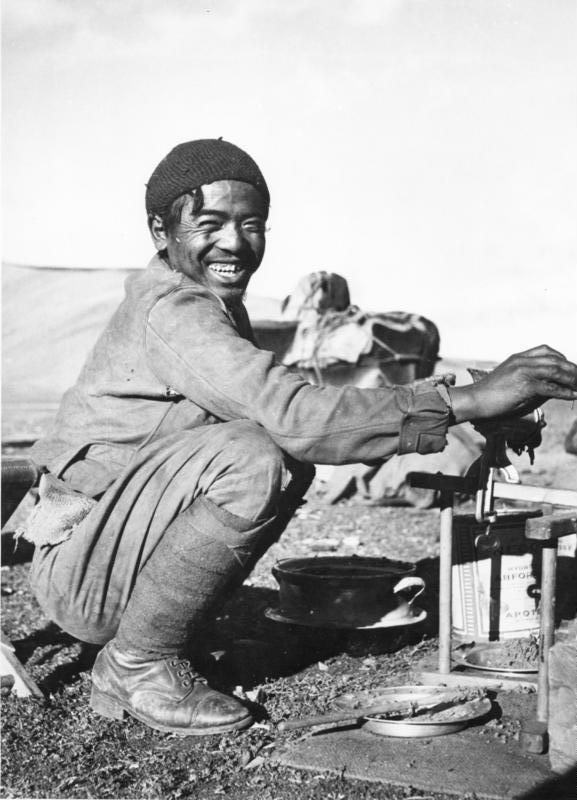 |
A Tibetan labeled Passang. Bundesarchiv, Bild 135-KB-16-055 / CC-BY-SA 3.0 File:Bundesarchiv Bild 135-KB-16-055, Tibetexpedition, Passang.jpg Created: 1938date QS:P571,+1938-00-00T00:00:00Z/9 |
|
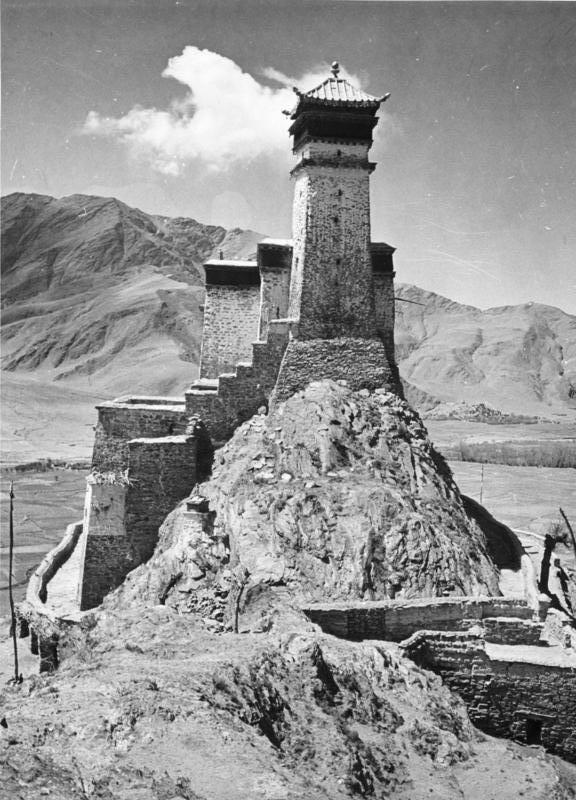 |
The Yumbulagang fortress as
photographed by Ernst Krause in 1938 Bundesarchiv, Bild 135-KB-06-088 / CC-BY-SA 3.0 File:Bundesarchiv Bild 135-KB-06-088, Tibetexpedition, Kloster, Yumbu Lagang.jpg Created: 1938date QS:P571,+1938-00-00T00:00:00Z/9 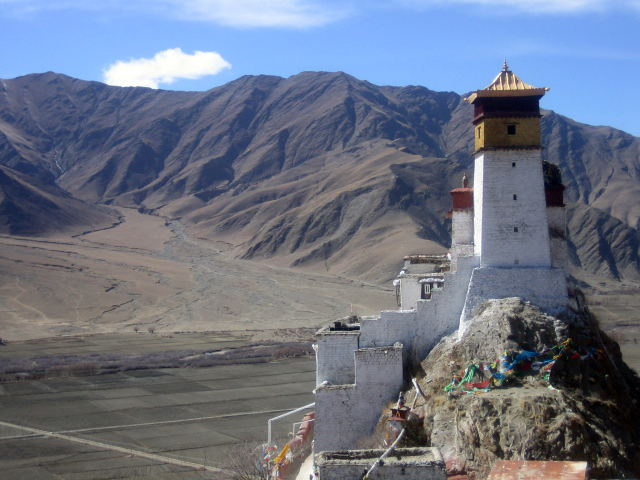 Yumbu Lhakhang,the first palace of Tibet, present time |
|
 |
A Golok woman,
photographed by Ernst Schäfer, Lhasa, Ngoloklager, junges Mädchen Bundesarchiv, Bild 135-S-12-37-25 / Schäfer, Ernst / CC-BY-SA 3.0 File:Bundesarchiv Bild 135-S-12-37-25, Tibetexpedition, Golok Mädchen.jpg Created: 1938date QS:P571,+1938-00-00T00:00:00Z/9 |
|
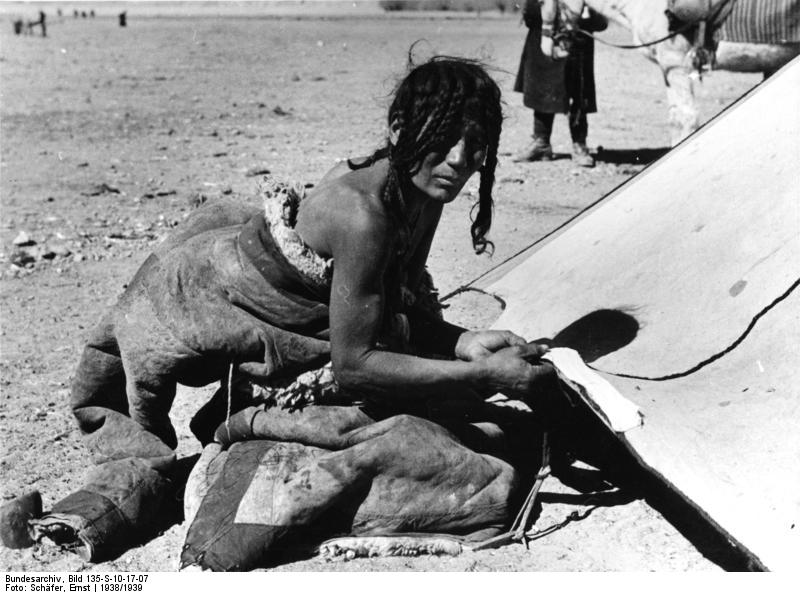 |
A Golok nomad in Lhasa Bundesarchiv, Bild 135-S-10-17-07 / Schäfer, Ernst / CC-BY-SA 3.0 File:Bundesarchiv Bild 135-S-10-17-07, Tibetexpedition, Golok, Nomade.jpg Created: 1938date QS:P571,+1938-00-00T00:00:00Z/9 |
|
 |
Golok camp (photo taken at the
1938–1939 German expedition to Tibet) Bundesarchiv, Bild 135-S-15-48-19 / CC-BY-SA 3.0 File:Bundesarchiv Bild 135-S-15-48-19, Tibetexpedition, Goloklager.jpg Created: 1938date QS:P571,+1938-00-00T00:00:00Z/9 |
|
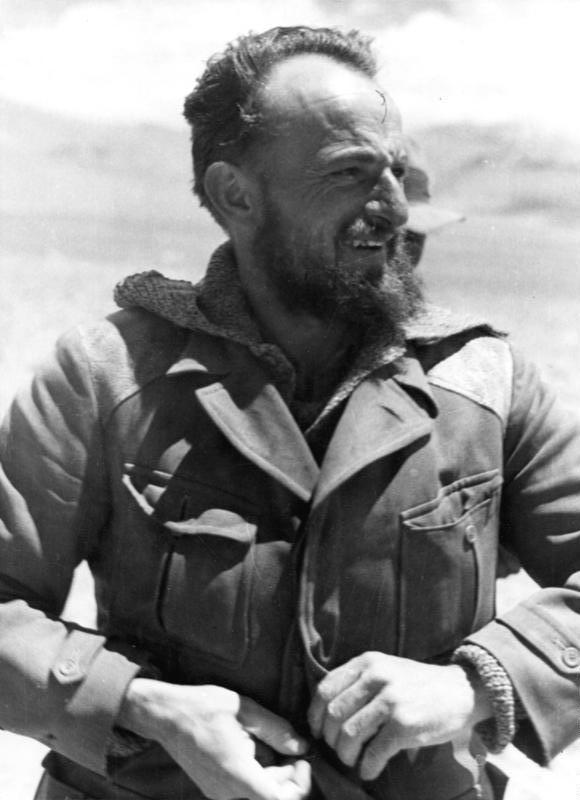 |
Ernest
Krause in 1938 during his expedition to Tibet Bundesarchiv, Bild 135-S-01-02-35 / Schäfer, Ernst / CC-BY-SA 3.0 File:Bundesarchiv Bild 135-S-01-02-35, Tibetexpedition, Ernst Krause.jpg Created: 1938date QS:P571,+1938-00-00T00:00:00Z/9 |
|
 |
Tibetexpedition, Neujahrsparade,
Rta pa Ernst Schäfer (1910–1992) File:Bundesarchiv Bild 135-S-14-13-34, Tibetexpedition, Neujahrsparade, Rta pa.jpg |
|
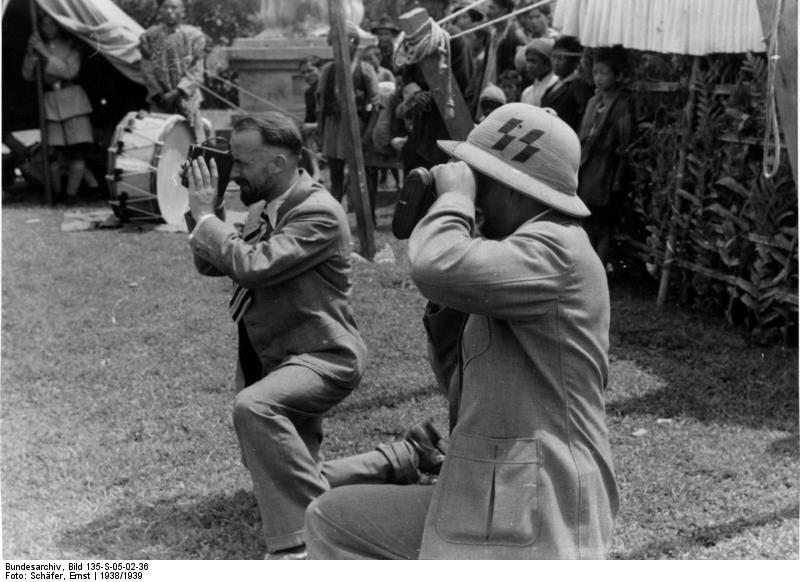 |
File:Bundesarchiv Bild
135-S-05-02-36, Tibetexpedition, Geer und Krause filmend.jpg Tibetexpedition, Geer und Krause filmend Gangtok(in Sikkim), Geer und Krause filmen, Krause, Ernst: Mitarbeiter im Sven-Hedin-Institut, Deutschland |
|
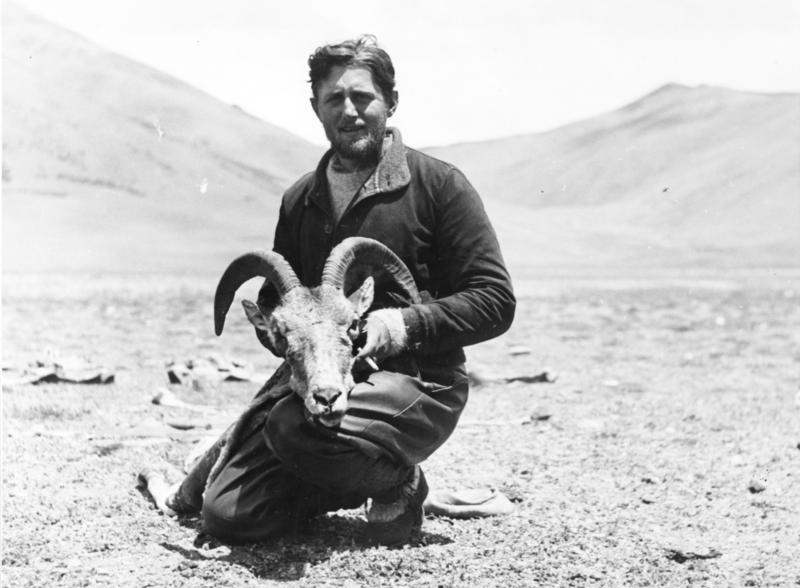 |
Tibetexpedition, Geer mit
Argali, 1938 File:Bundesarchiv Bild 135-KB-17-040, Tibetexpedition, Geer mit Argali.jpg |
|
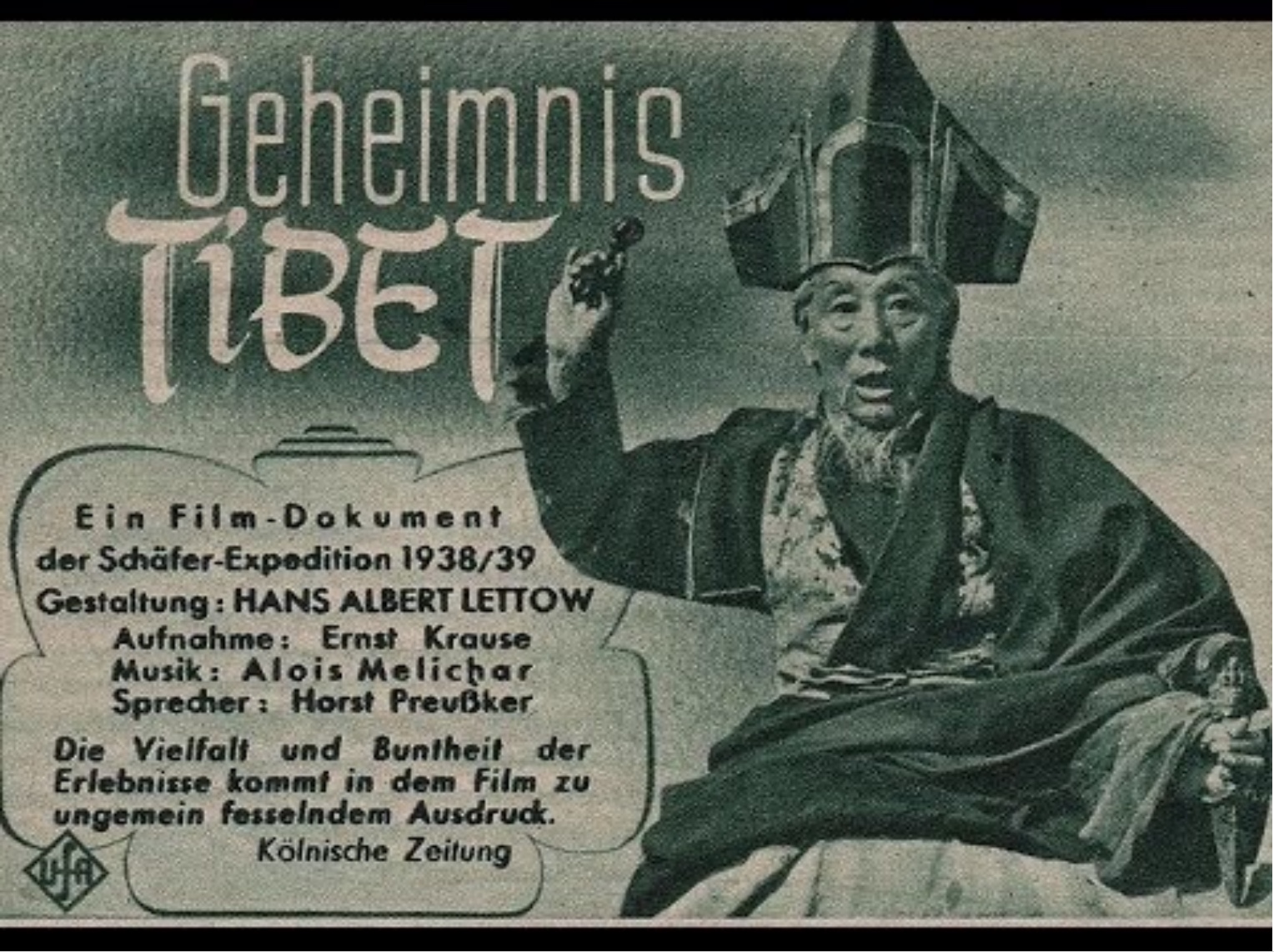 |
『秘密のチベット(Geheimnis Tibet)』
は、ハインリヒヒムラーによって推進され、1943年に初演された、1938/39年のドイツチベット遠征に関するドイツのドキュメンタリーである。映画
の初演は、1943年1月16日にミュンヘンのウファ宮殿で行われた。 【内容; Inhalt】Der Film wurde aus Filmmaterial zusammengestellt, das 1938/1939 von den Teilnehmern der Expedition in Tibet gedreht wurde. Eingang in den Film fanden unter anderem traditionelle tibetische Tänze für den vermeintlich als "Kriegsgott" interpretierten "Schützer" Mahakala, Präsentationen des tibetischen Militärs, Toten- und Leichenrituale der Tibeter sowie Filmsequenzen mit dem tibetischen Staatsorakel. Auch die Messungen und Abformungen von Körperteilen der Tibeter, mit denen die NS-"Wissenschaftler" ihre Rassentheorien untermauern wollten, fehlen nicht. 【レヴュー:Bewertung】 Vordergründig eine Kulturdokumentation Tibets, beschwört der Film auf propagandistische Art erwünschte Tugenden: „Schäfer und seine Forscherkollegen wurden als ‚Typen‘ dargestellt, an denen sich jeder ‚normale‘ SS-Mann und Hitlerjunge orientieren konnte“.[1] Die Unterscheidung zwischen Ideologie und Dokumentation tibetischer Kultur fällt schwer: „Der Film wirft die Frage auf, was ist daran Nazi-Propaganda und was sind authentische Darstellungen. Immerhin nimmt der Zuschauer hier bewegte Bilder wahr, die sprechen und die von zahlreichen Berichten westlicher Tibetreisender, auch wenn diese keine Nazis waren, bestätigt wurden.“[1]Heute, unter dem Eindruck anderer Bilder über Tibet aus Filmen wie Sieben Jahre in Tibet oder Kundun, wird von der Bundeszentrale für politische Bildung konstatiert: „Die Filmbilder, die auf dieser Forschungsreise gedreht wurden, kollidieren in ihrer Archaik mit den sanften Tibet-Vorstellungen des modernen Kinos.“[3] Der Film wurde vom Reichsministerium für Volksaufklärung und Propaganda als „jugendwert sowie staatspolitisch, kulturell und künstlerisch wertvoll“ eingestuft.[4] |
|
 |
||
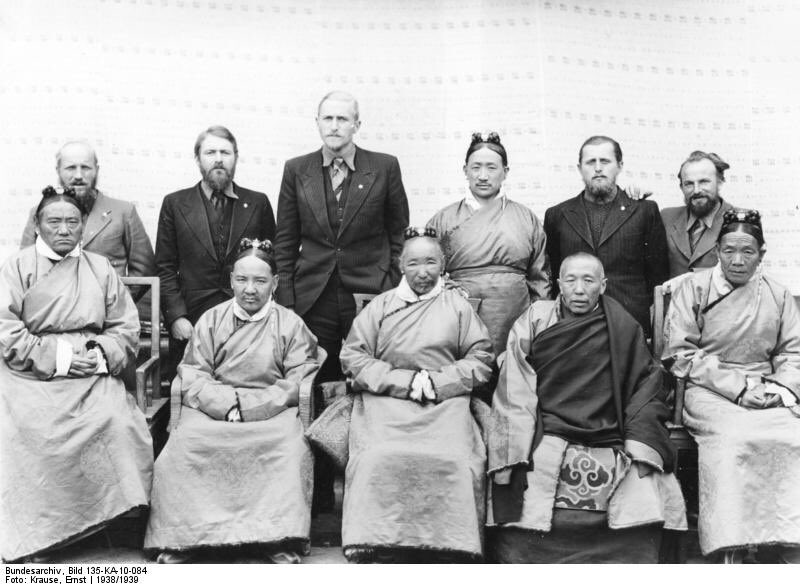 |
||
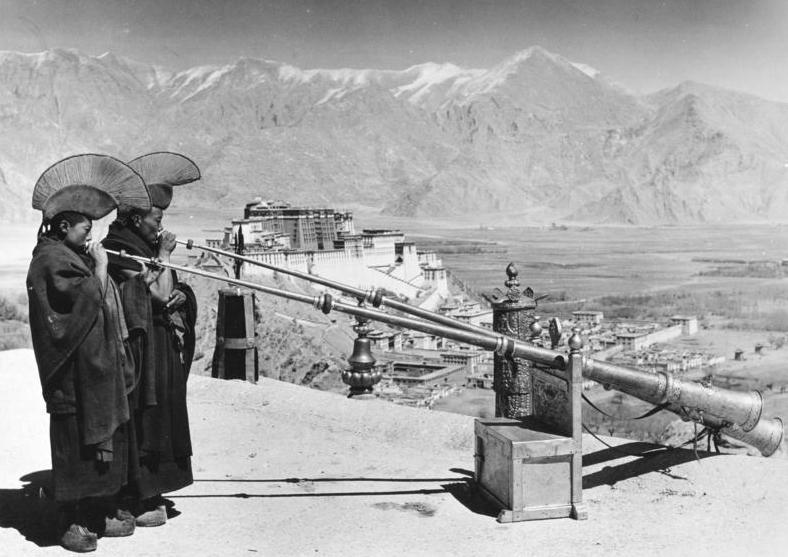 |
1938 Lhasa with the Potala as
seen from the roof of Men-Tsee-Khang or Tibetan Medical College founded
by the 13th Dalai Lama Bundesarchiv, Bild 135-KA-07-089 / CC-BY-SA 3.0 File:Bundesarchiv Bild 135-KA-07-089, Tibetexpedition, Mönche mit Blasinstrumenten.jpg Created: 1938date QS:P571,+1938-00-00T00:00:00Z/9 |
|
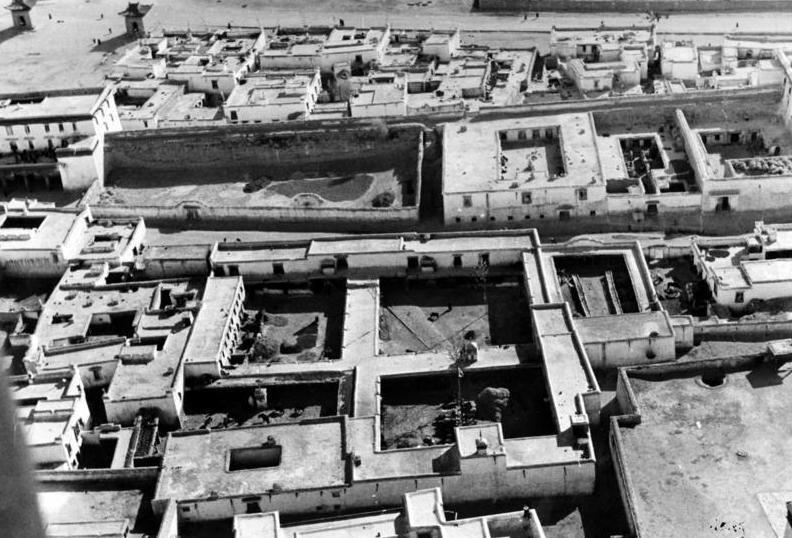 |
Inner and outer Zhol Village as
seen from the Potala Palace in 1938. Bundesarchiv, Bild 135-S-12-09-14 / Schäfer, Ernst / CC-BY-SA 3.0 File:Bundesarchiv Bild 135-S-12-09-14, Tibetexpedition, Wirtschaftsgebäude des Potala.jpg Created: 1938date QS:P571,+1938-00-00T00:00:00Z/9 |
|
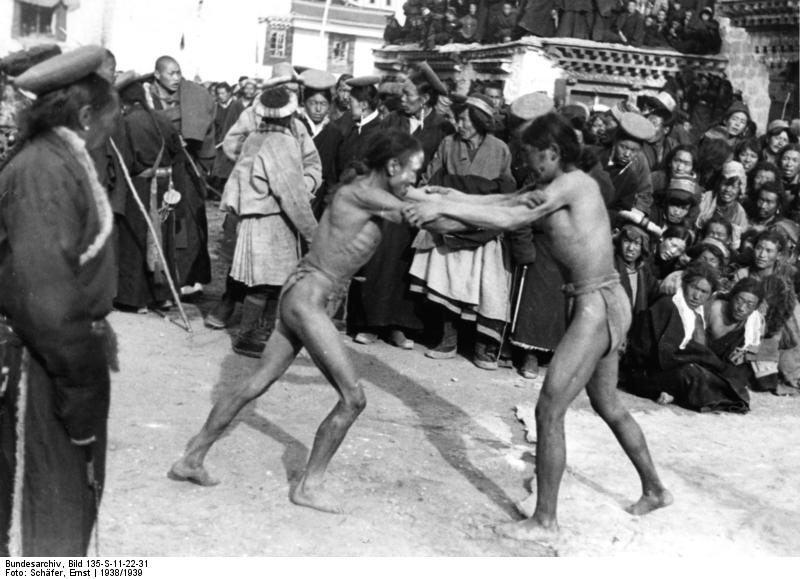 |
Wrestling in Lhasa, 1938 Bundesarchiv, Bild 135-S-11-22-31 / Schäfer, Ernst / CC-BY-SA 3.0 File:Bundesarchiv Bild 135-S-11-22-31, Tibetexpedition, Neujahrsfest Lhasa, Ringkampf.jpg Created: 1938date QS:P571,+1938-00-00T00:00:00Z/9 |
|
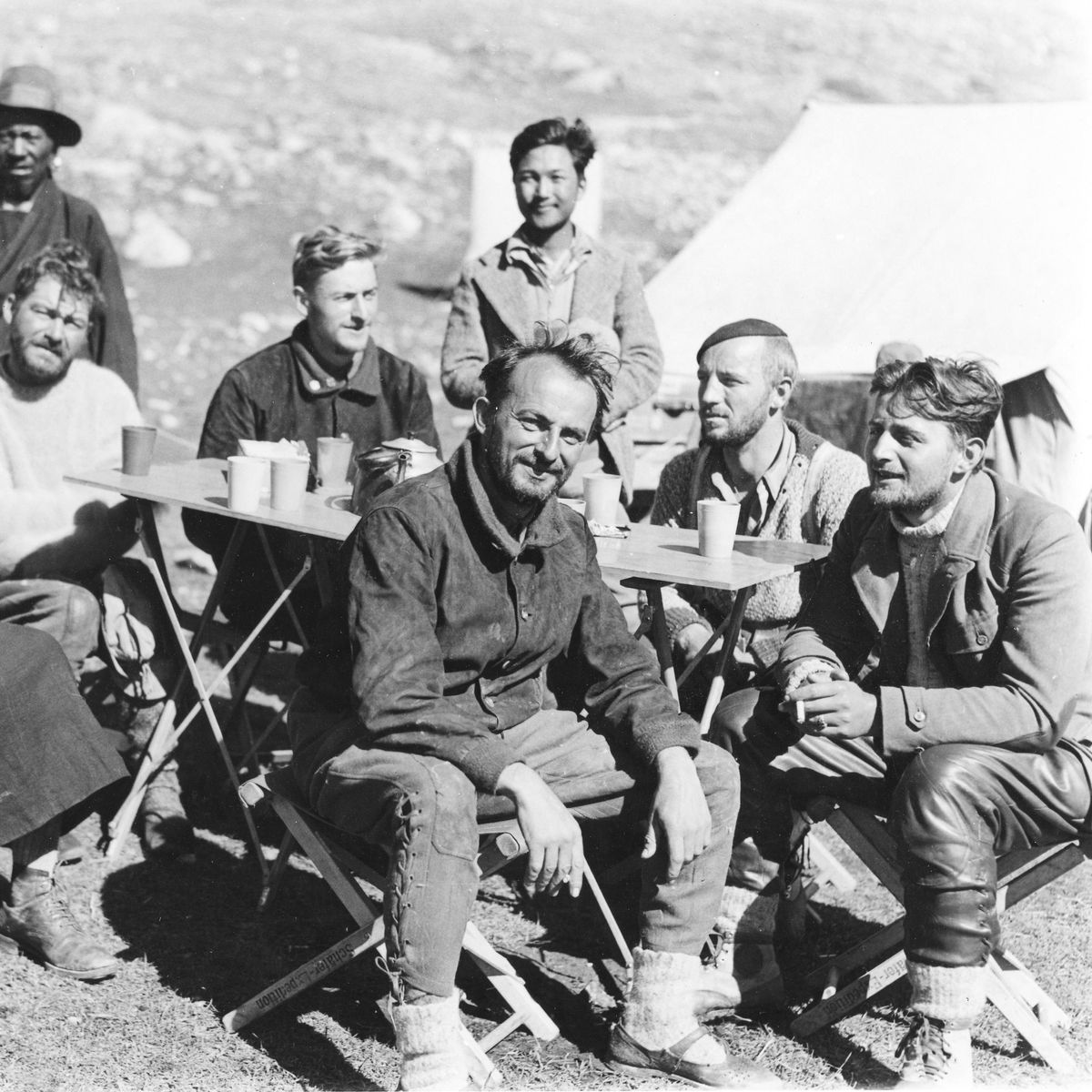 |
Die
abenteuerliche Nazi-Expedition in den Himalaja, Von Matthias
Schulz. 24.03.2017, Spiegel Wissenshaft. Gayokang, Expedition mit dem Minister des Königs von Tharing Foto: Ernst Schäfer/Bundesarchiv 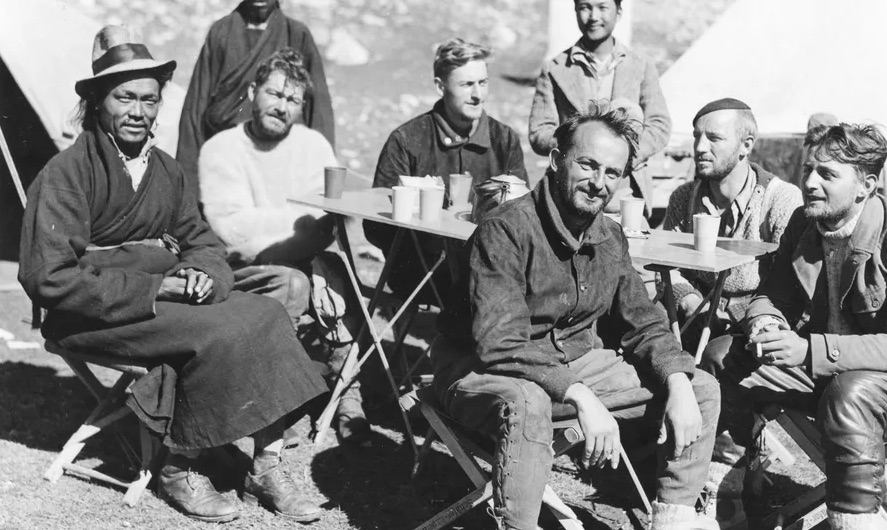 |
|
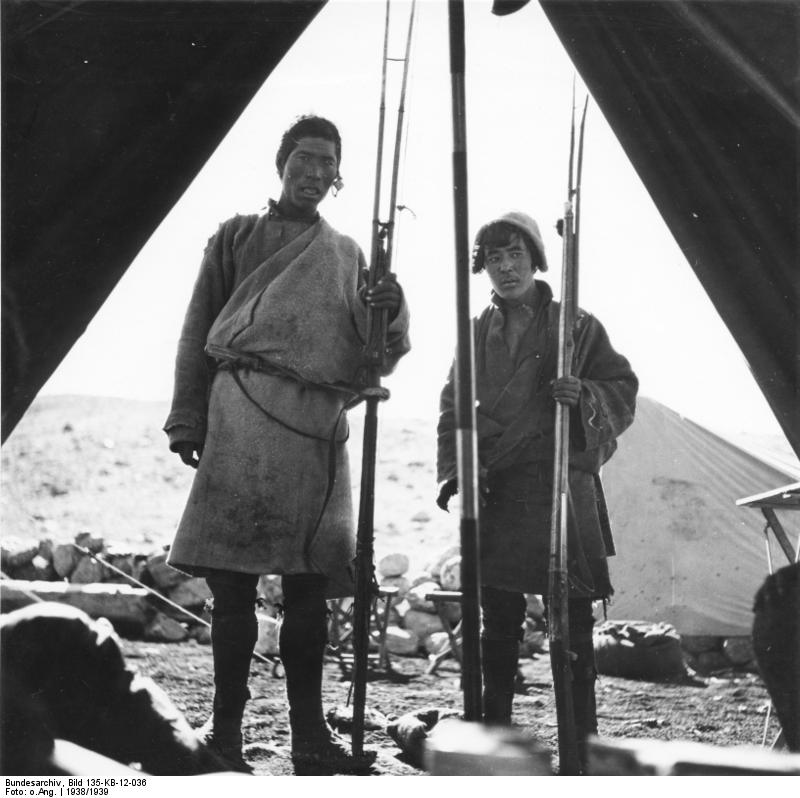 |
Tibetexpedition, Tibeter mit
Gabelflinten Gayokang, Tibeter mit Gabelflinten vor unserem Zelteingang
in Gayokang Bild 135-KB-12-036 https://www.bild.bundesarchiv.de/dba/de/search/?query=Bild+135-KB-12-036 |
|
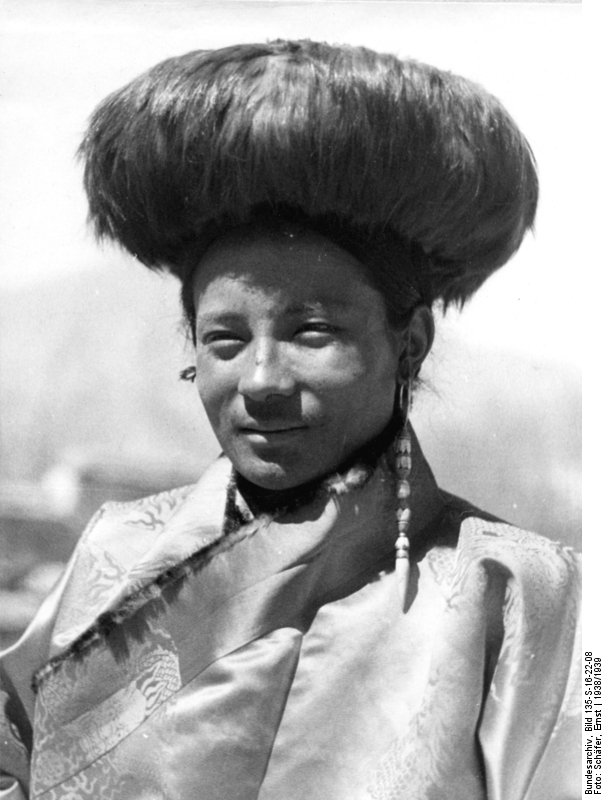 |
Rapten Kazi, interpreter and
master of etiquette, in New Year’s dress Photographer: Schäfer, Ernst / Licence CC-BY-SA 3.0 Bild 135-S-16-22-0 |
|
 |
Zemu
Region. The Five Members of the Expedition. [left to right: Geer,
Wienert, Krause, Beger, Schäfer] Photographer: Krause, Ernst / Licence
CC-BY-SA 3.0 Bundesarchiv: Bild 135-KA-03-076 1) Geer, Edmund. (キャリア不詳):登山家 2) Wienert, Karl A.(地学者?) Karl Wienert, Rilevamenti del magnetismo nel Tibet (イタリア語, 1945) Detections of magnetism in Tibet 3) Krause, Ernst: Mitarbeiter im Sven-Hedin-Institut, Deutschland:昆虫学者 4) Beger, Bruno Dr.: SS-Hauptsturmführer, Abteilungsleiter Sven-Hedin-Institut, Deutschland (GND 128720654):自然人類学者 5) Schäfer, Ernst Dr.: SS-Sturmbannführer, Leiter des Sven-Hedin-Institutes, Deutschland (GND 123991420):鳥類学者、探検隊長 |
|
 |
Krause, Ernst撮影[von links nach
rechts(左から右へ): Wienert, Schäfer, Beger, Krause, Geer] Bundesarchiv_Bild_135-KA-01-039,_Tibetexpedition,_Expeditionsteilnehmer.jpg |
|
06. スヴェン・ヘディン内陸アジア研究所(1934年1月1日〜1945年12月31日)
1943年1月16日研究所設立、1940年に設立
されたアーネンエアベの
内陸アジア教育研究センターおよび遠征センターが、帝国科学・教育・国民教育省の予算監督の下でミュンヘン大学に所属、任務は次のとおりである。1938
-39年のチベット探検の成果の評価と出版、アジア探検家スヴェン・ヘディン、ヴィルヘルム・フィルヒナー、リックマー・リックマーの遺産を長期的にさら
に発展させ、包括的な「自然科学と文化科学の完全統合という意味での全人的科学」。ハインリッヒ・ヒムラーのために数々の特別任務やプロジェクトを実施し
た。(ブンデス・アーカイブの)Bild 135コレクションには、SSチベット遠征の記録が11件ある。
07. DFGの沿革, German
Research Foundation - Deutsche
Forschungsgemeinschaft.
1920 10月30日化学者のフリッツ・ハーバーと初代大統領になったフリードリヒ・シュミット・オットの主導でドイツ科学の緊急協会として設立
1929 ドイツ研究保存促進協会、または略して (ドイツ)研究協会に変更。ただし、Notgemeinschaft は、資金提供を受けた出版物で引き続き使用
1933 ナチス政権を歓迎し、「過激なナショナリ ストの基本的コンセンサス」の枠組みの中でその目標に自発的に取り組む
「人種衛生学」や農学などの政治的に受け入れられる
研究分野への資金提供は大幅に増加。Volksforschung
(民族研究)では、戦争中の科学者がポーランドのインテリゲンチャとユダヤ人の全滅を計画された(→1942年ヴァンゼー会議(Wannseekonferenz)。
1934 12億ライヒスマルクが投資される。
1934-1936 DFG会長は物理学者のヨハネ ス・シュタルク(Johannes Stark, 1874-1957)。
彼はナチスの主たるイデオローグのアルフレッド・ ローゼンベルク(Alfred Ernst Rosenberg, 1892/1893-1946)をDFGのパトロン兼名誉会長に任命した。しかし。ベルンハルト・ルストと彼の省庁の役人に加えて、SSとドイツ国防軍も ローゼンベルクに反対したため、シュタルクは彼の立場を失うことになる。
1936 以降の民族絶滅政策と科学者たち。
「歴史家、特にゲッツ・アリーとウルリッヒ・ハー
バートらの研究によると、DFGは国家社会主義時代の「東部総合計画」の発展に多大な貢献をした。東ヨーロッパの何百万人もの人々の死は、人口、ビジネ
ス、国民経済の観点から正当化された。[23]
[24]「総合計画」によれば、いわゆる民族ドイツ人は、先住民が以前に殺害(「全滅」)または追放(「移転」)された東ヨーロッパ地域に定住することに
なっていた。この計画は、主にソビエト連邦に対するドイツ帝国の軍事的敗北のために部分的にしか実施されなかったが、歴史家は、当時の東ヨーロッパでの死
者数は約3,300万人と推定している」
1942 1936年から、科学者ルドルフ・メン ツェル(Rudolf Mentzel, 1900-1987)は、DFGの会長であり、 SS少将のランクを持つSSのメンバーだった。(1942年)。研究コミュニティは、ナチス強制収容所でのほぼすべての人体実験に資金を提供した。
1944 1944年まで、DFGは、Robert Ritter (Robert Ritter, 1901-1951)の人種衛生研究センター(Rassenhygienische Forschungsstelle)の「社会的および刑事生物学的研究」などのプロジェクトに資金を提供する。
1945 GEPRISHistoricalの情報 ポータルには、1920年から1945年までの資金調達ファイルとトピックが含まれている
1949 再建、Notgemeinschaft derDeutschenWissenschaft. 3月9日、科学政治志向のドイツ研究評議会がゲッティンゲンで設立
1951 8月2日、
NotgemeinschaftとForschungsratが合併して、Deutsche
Forschungsgemeinschaft(DFG)を形成。
08. 歴代入蔵邦人(→詳しくは「日本人による入蔵の歴史」を見よ)History of Japanese expedition to Tibet, from Buddhist quest to Military intelligence
文献:日本人チベット行百年記念フォーラム実行委員
会 編『チ
ベットと日本の百年:十人はなぜチベットをめざしたか』新宿書房、2003年
+++
Links
リンク
文献(Bruno Beger関係)
文献
その他の情報



++
Copyleft, CC, Mitzub'ixi Quq Chi'j, 1996-2099
☆
 ☆
☆